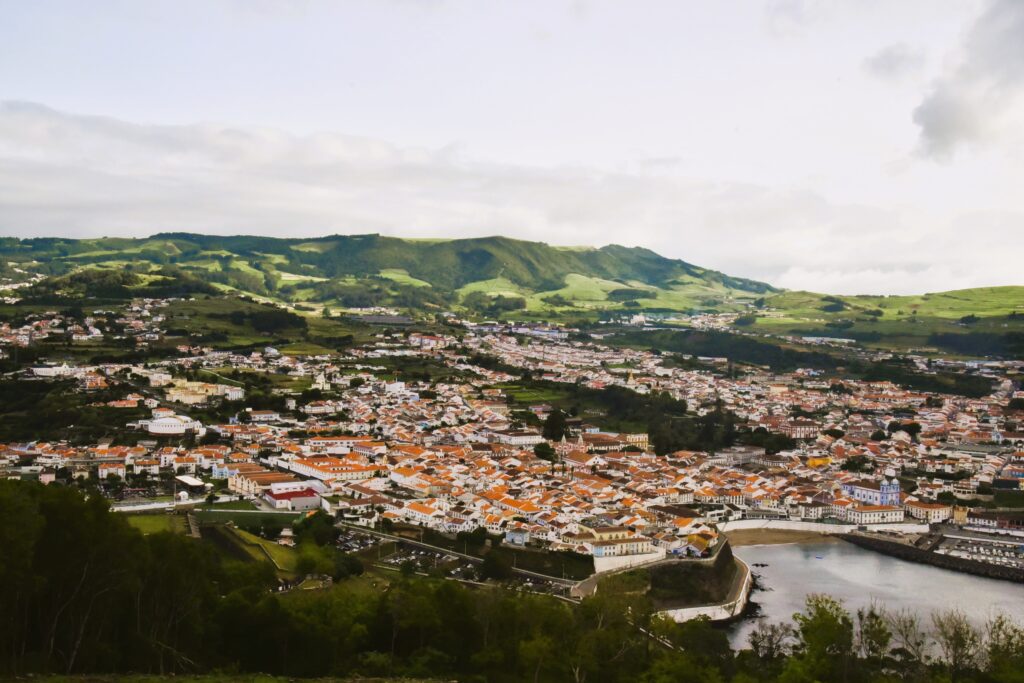
15 Reasons to Explore the Amazing Azores Islands
The Azores Islands consist of nine large islands that float lazily in the Atlantic Ocean, midway between Portugal and the United States. Are you thinking, “pit stop”? Hold that thought—it’s a good place to make a quick stop while traveling on long international flights!
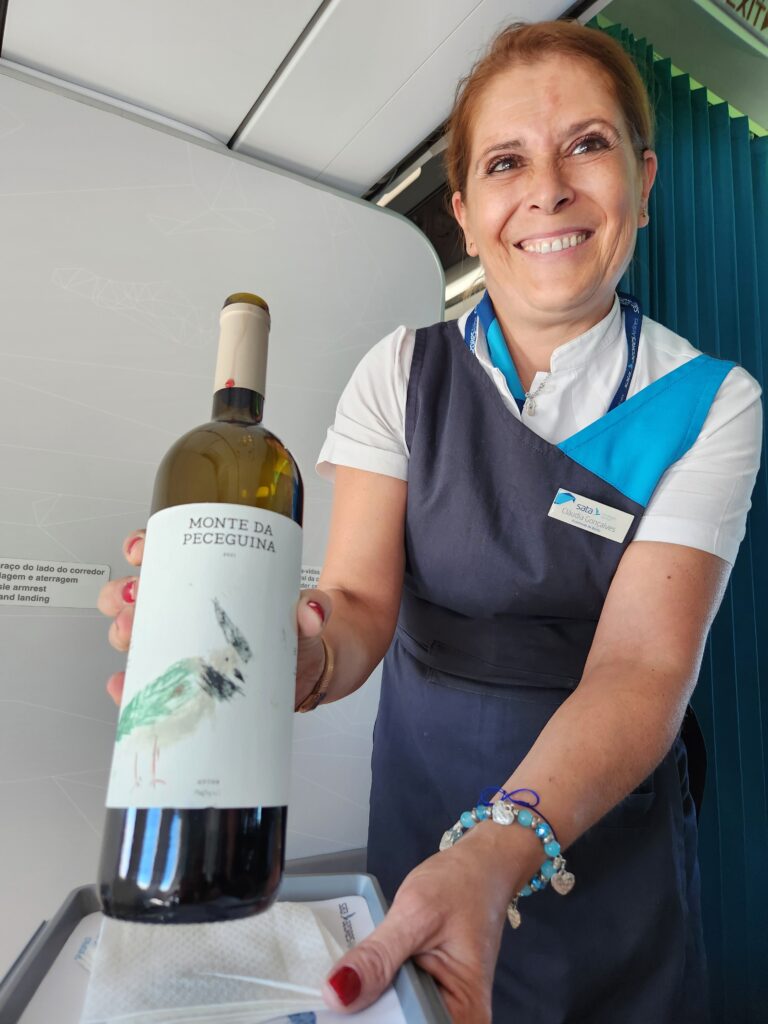
Azores Airlines (formerly known as SATA) has direct flights to the Azores from North American terminals in New York, Boston, Toronto, and Montreal. They also fly to Lisbon, Porto, Cape Verde, and points in France, Germany, Spain, and Africa. Plan your trip right, and you could spend a couple of days in the breathtaking Azores before jetting off to one of many possible destinations.
Table of Contents
Azores Islands Background
The islands are an autonomous region of Portugal, deserving of their nickname, “Hawaii of Europe,” and are an outdoor lover’s dream. My first visit to this European paradise was to Terceira and nearby São Jorge, a short distance of 25 miles. The four-hour ferry ride was exchanged for a thirty-minute flight, saving a whole day for doing fun things in São Jorge. The volcanic islands are lush green hillsides covered with vegetation, green pastures, and hedgerows of the Azores’ iconic blue hydrangeas bordering the roadways.
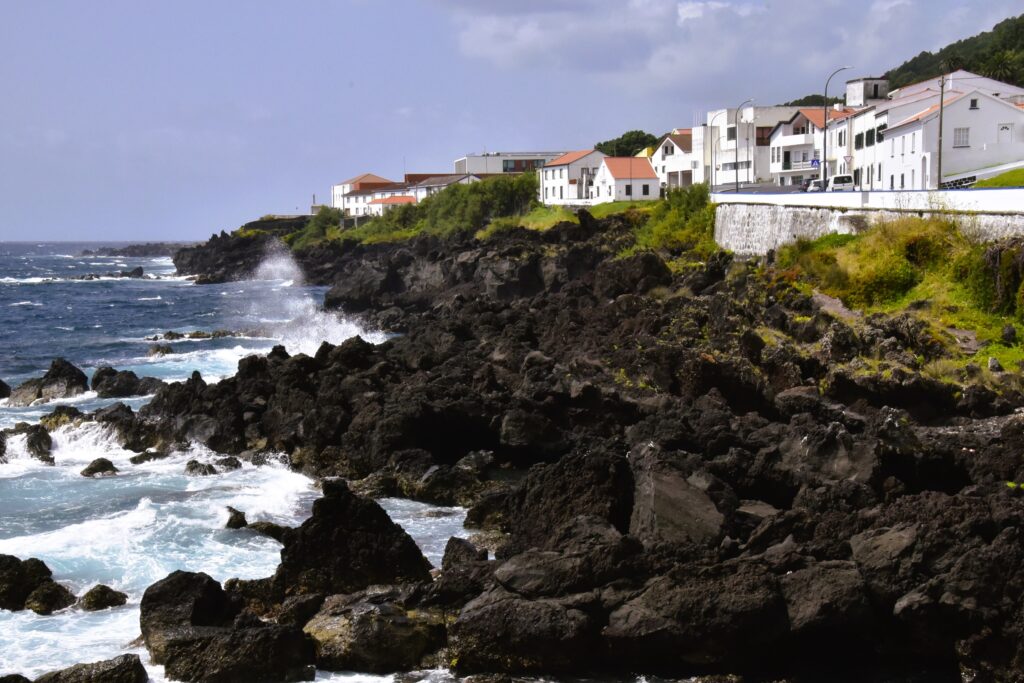
The largest islands are São Miguel Island and Pico Island; five smaller islands in this group are part of Portugal. The island of São Miguel is the home to the capital city of Ponta Delgada.
Other islands are Faial, Flores, Santa Maria, Graciosa, and tiny Corvo, a small island of only seven square miles. While I look forward to exploring different spots on a future trip, at the same time, the natural beauty of Terceira and São Jorge are calling for me to return.
Rustic São Jorge is formed from a long volcanic ridge, and at the bottom of coastal cliffs of lavic fajas, the cliffs drop into the sea.
Terceira Island is composed of four large volcanoes and a zone of basaltic rock. One of those volcanoes is open to the sky, which is unusual because the cap of a volcano usually implodes. We walked to this magnificent volcano’s bottom, awed by its lush greenery.
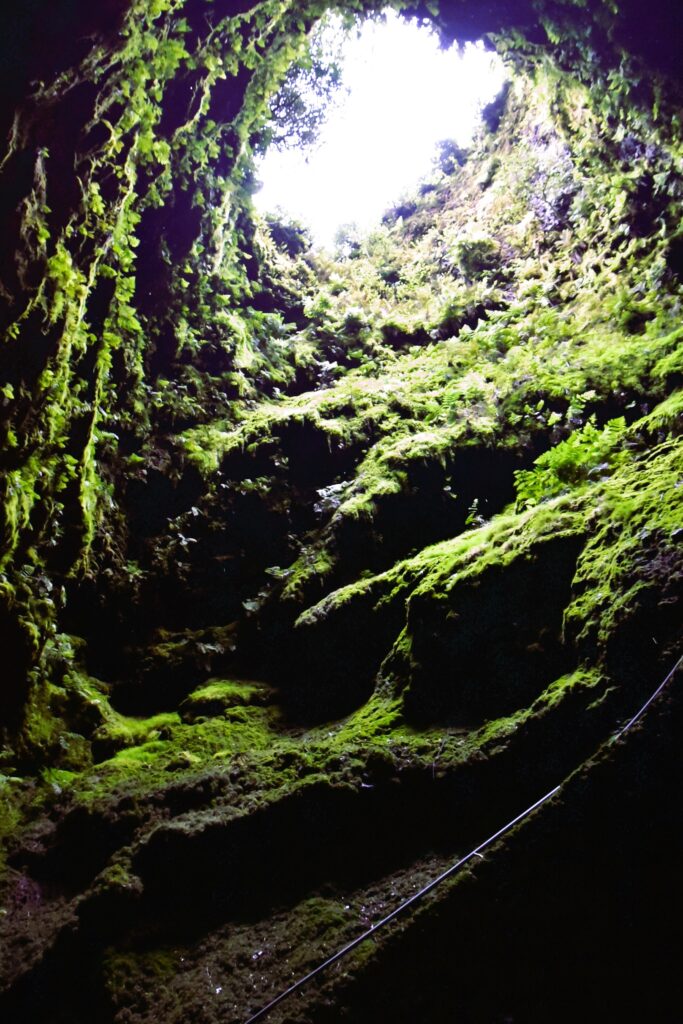
Terceira has something different to see depending on your travel direction: the western part holds mountains that cover more than half the island, and the eastern section which is mostly flat. So, on this 155 square mile island has various landscapes, from the plains to mountains to the ocean.
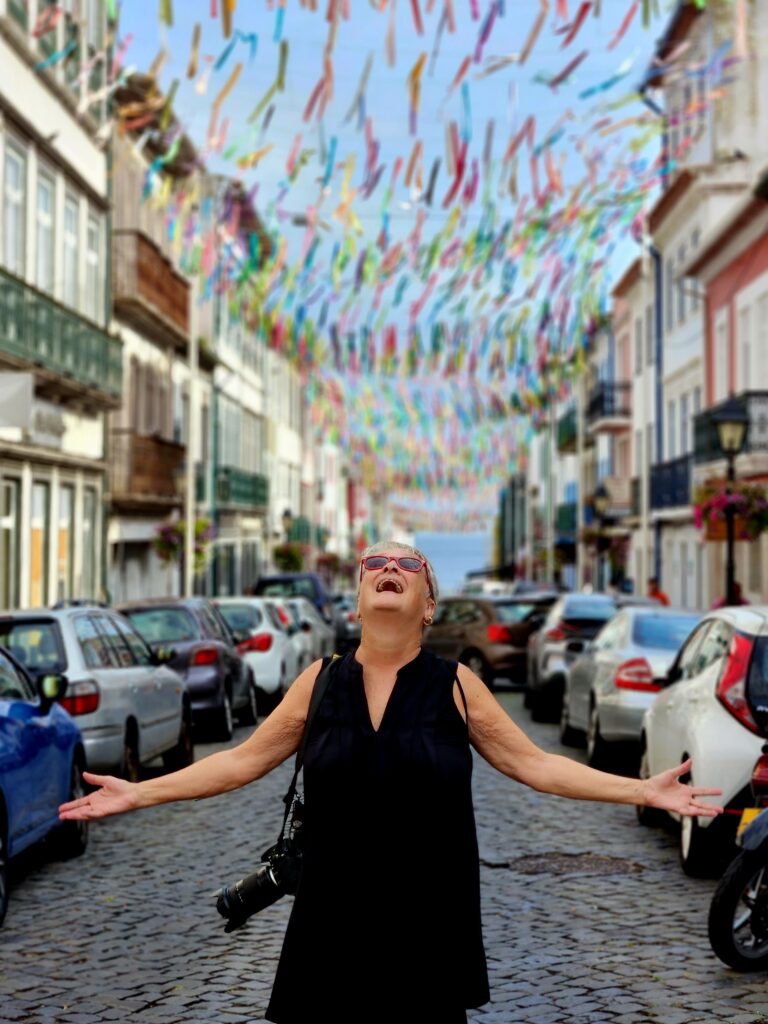
Why Go to the Azores Islands
The Azores are islands—’nuff said? *smile* The islands were formed by volcanoes and have dramatic landscapes, rocky coastlines, hiking trails, and whale watching. On my Picos de Aventura whale watch tour, I spotted four different types of dolphins, but, alas, there were no whales that day.
Besides all the natural beauty, historic areas are filled with centuries-old churches, delicious seafood, gardens filled with glorious flowers, windmills, parks, cheese factories, and donkey farms. Whew! You will need more than a few days to soak in this place’s spectacular scenery and quiet beauty. If you do your research you’ll find lots of help to plan your Azores trip.
Angra do Heroísmo was declared a UNESCO World Heritage Site in 1983. Angra, Terceira’s port city, linked the island to maritime expansion since ships from South America, Africa, and the Indies stopped here. They used the port to trade spices, wood, ivory, delicate fabrics, religious imagery, and precious metals from the Americas. Philip II built the largest stronghold of Europe in the 1580s, his great fortress in Angra.
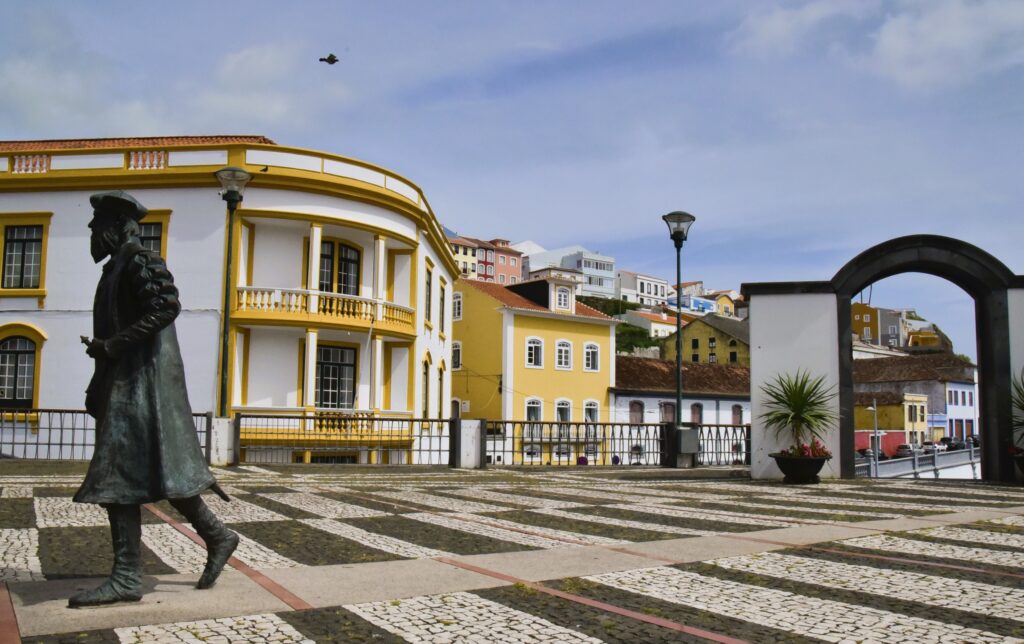
Fortress São João Baptista
Today, Monte Brasil encompasses a three-square-kilometre area. Álvaro de Bazán received the title Álvaro the Great of Spain when he finally took control of the Azores in 1583 after his conquest of Terceira Island. It ended a three-year military campaign.

Monte Brasil is an excellent area for hiking or simply enjoying the military history on display, including the Fortress of São João Baptista. Three volcanic eruptions in the caldera formed Monte Brasil; one, called a submarine eruption, formed Pico do Zimbreiro e Pico do Facho. This high point provides breathtaking views of the area.
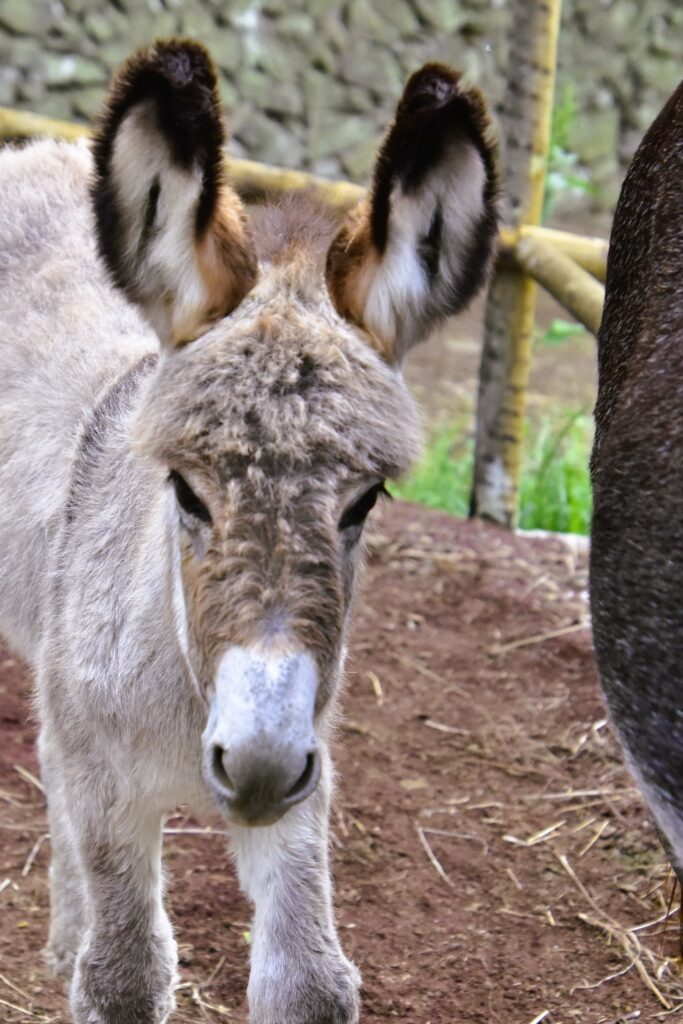
Asinus Atlanticus Donkey Farm
We spent a morning with donkeys. We petted them, brushed them, fed them, and milked them. Yes, you heard me right. I milked a donkey. And let me tell you, it was much easier than milking a cow! The milk was good, too, and low in lactic acid (which is a plus for me since I’m lactose intolerant.) It seemed thinner than cow’s milk and tasted a little like grass.
Asinus Atlanticus was established in 2012 and sells donkey milk to drink and donkey milk creams, lotions, and shower gel. For centuries, the milk was used as an anti-aging solution, and rumor says that Cleopatra bathed in donkey’s milk to preserve her youthful skin. It is also an ideal substitution for mother’s milk. The milk is naturally low in fat and rich in omega-3.
The miniature donkeys are an endangered species, so the farm is helping save them and establishing a line of healthy products in the Azores Islands. The skincare line is called Mythica, A Timeless Secret. The farm ships donkey milk products worldwide.
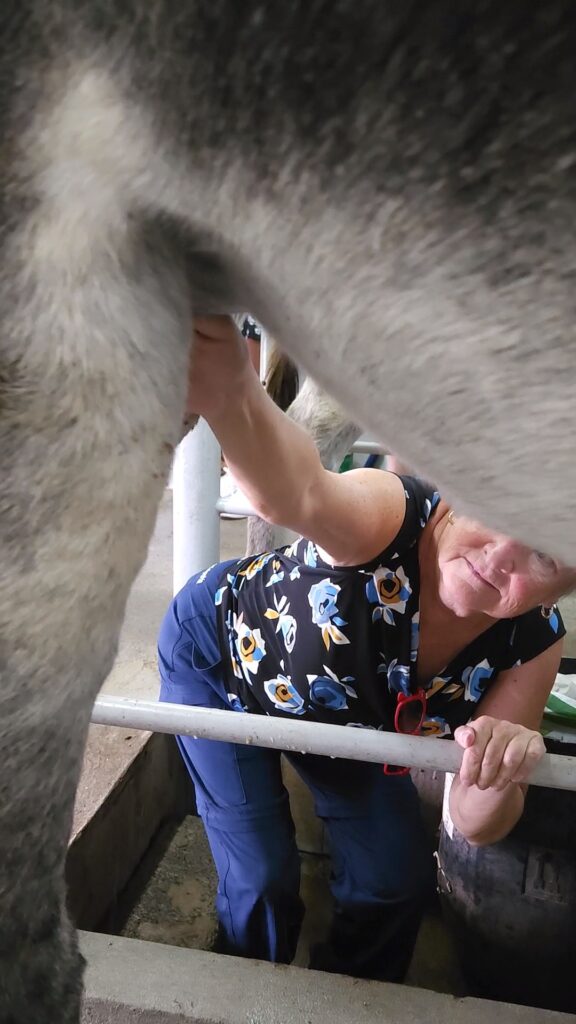
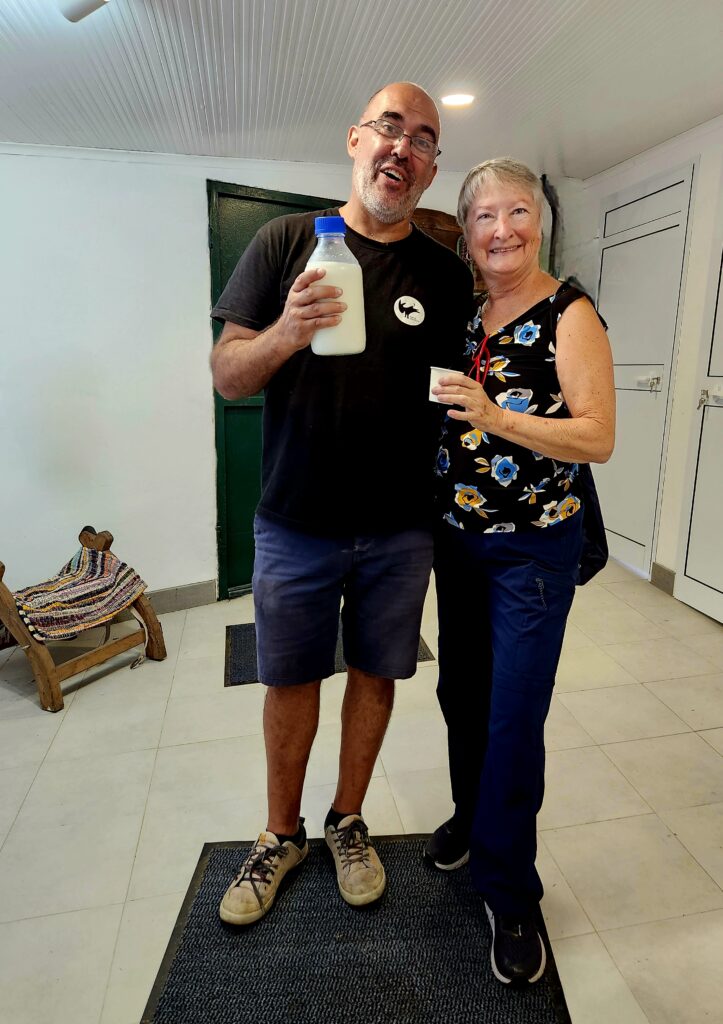
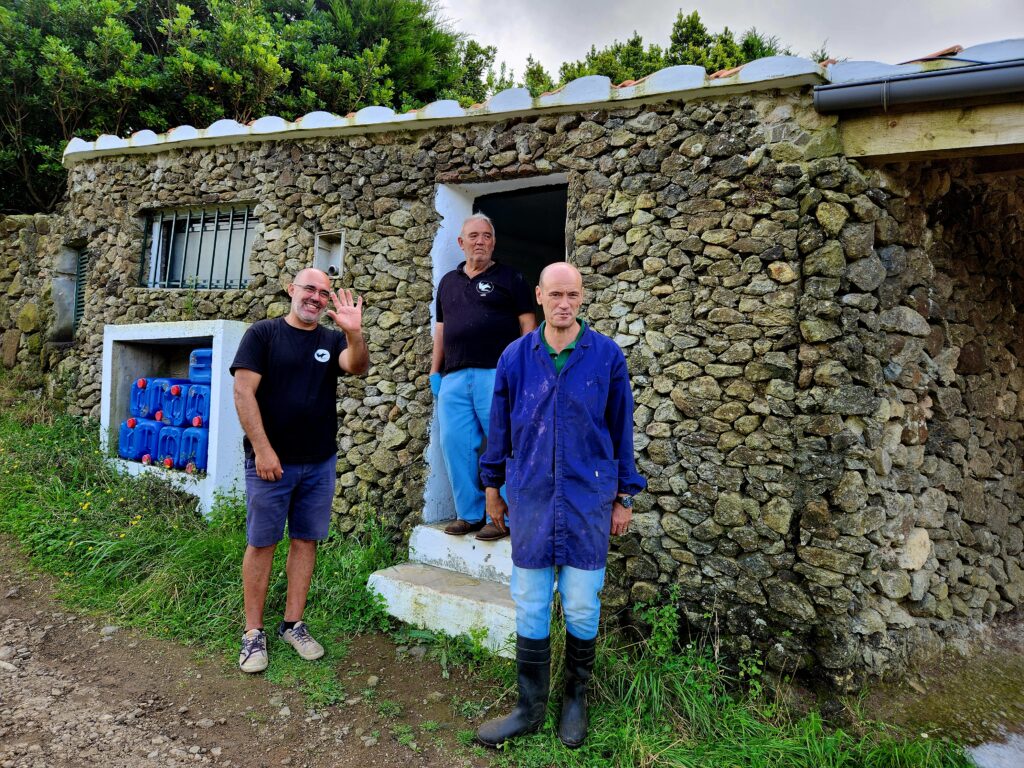
Quinta do Martelo
This living history museum teaches us how Terceira settlers lived. It makes us appreciate that we no longer have to work hard for a meal. Quinta do Martelo tells how it (and similar places) began as tascas. These inns operated in cellars and backyards, serving neighbors and passing travelers food and drink. In Colonial America, they would have been called “ordinaries” and, later, “taverns.”
The Portuguese Venda, or small neighborhood grocery store, followed, always with a counter for serving food and drink. To expand, space was attached to provide tables for food service and playing dominoes, checkers, and other competitive games of the day.
The evolution continued as customers requested more substantial foods, and restaurants and taverns were born. The name Quinta do Martelo (Hammer Farm) was found inscribed on an 18th-century door knocker, still handing on the main gate.
The working farm produced wine and loquat brandy. Loquat, orange, and other fruit trees still thrive here, along with horticultural crops used in the traditional restaurant’s daily meals.
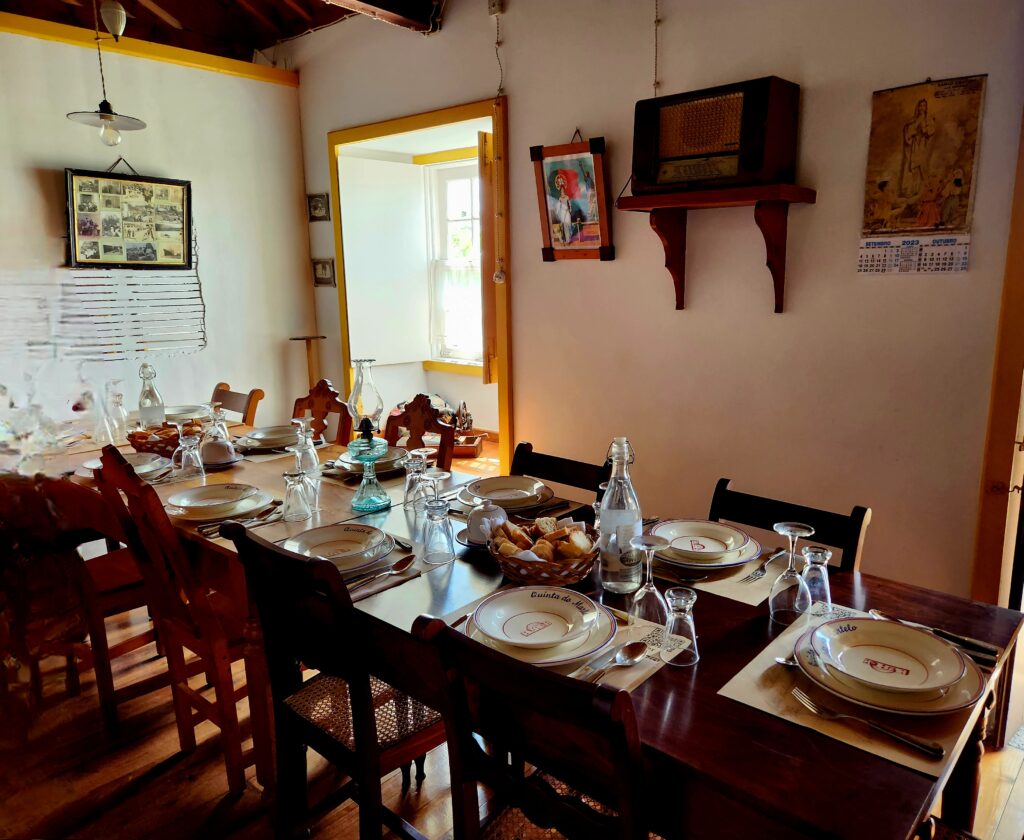

Visitors explore reconstructed workshops, traditional dyeing works, and houses dating from the Azore’s colonization. It is an education in agricultural and organic farming in the Azores. It preserves indigenous species of domestic animals depicting life five centuries ago.
The grocery preserves food history. The grocery store serves snacks and full meals on the upper floor. Traditional bread, meats, and vegetables provided a hearty lunch and earned Quinta do Martelo a first-place award for “Gastronomy – National Heritage.”
You can stay on the property in the original buildings (with modern conveniences like air conditioning, showers, and Wi-Fi). We did not spend a night here, but the accommodations tempt me to return.
Natural Wonders of Terceira in the Azores Islands
The Terceira Natural Park is the largest park in the Azores archipelago. The Natural Park consists of 20 protected areas throughout the island and into the adjacent sea.
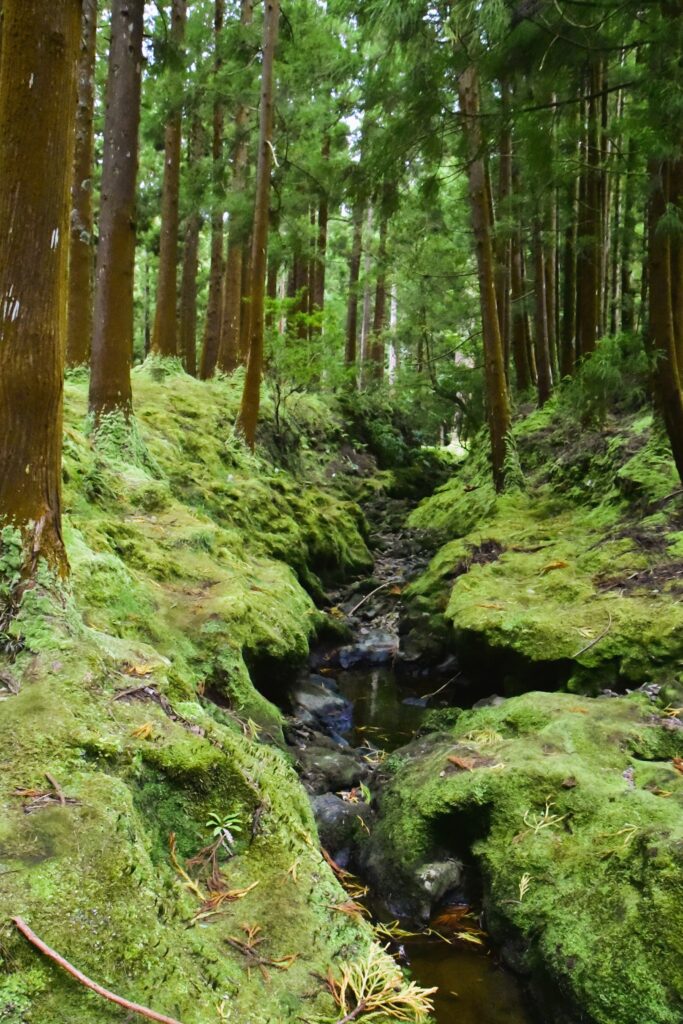
Serra do Cume
This view of Terceira’s “patchwork blanket” is an iconic picture of the island. More than a third of a mile (545 meters) above sea level, you can stop on an interior road to enjoy an observation deck overlooking this plain. One of the earliest volcanoes that created Terceira Island formed this caldera, now separated by volcanic stone walls into “cerrados” as pastures for cattle.
Travel Photographer Tip: Although it is beautiful any time of day, the Serra do Cume would be stunning at sunset.
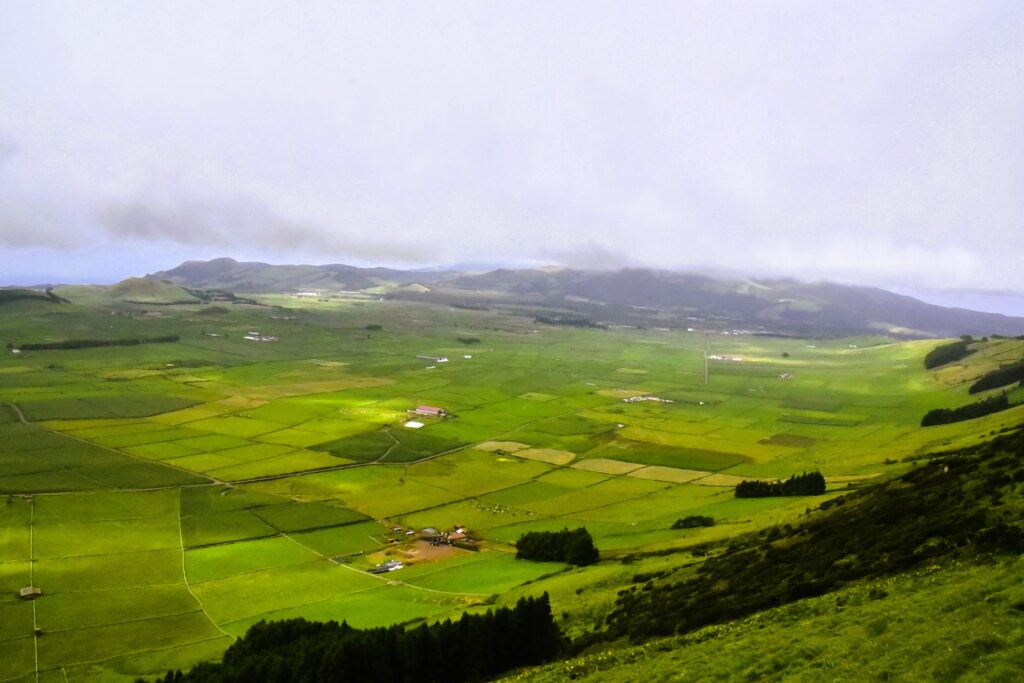
Ilhéus das Cabras
Ilhéus das Cabras, or the Cabras Islet, provides a nesting place for various marine and bird species living along Terceira’s southern coast. Now uninhabited, early shepherds used the islets to harbor sheep and goats.

Algar do Carvão Volcanic Chimney
Have you ever walked inside a volcano? Can you even imagine what the inside of a 3,200-year-old volcanic chimney would look like? This is one of only a few volcanos in the world that didn’t lose its cap. In Terceira, you can find out what a 90-meter-deep volcano looks like (hint: it isn’t all black and charred!) Picture verdant greenery, and you will have a start on that image!
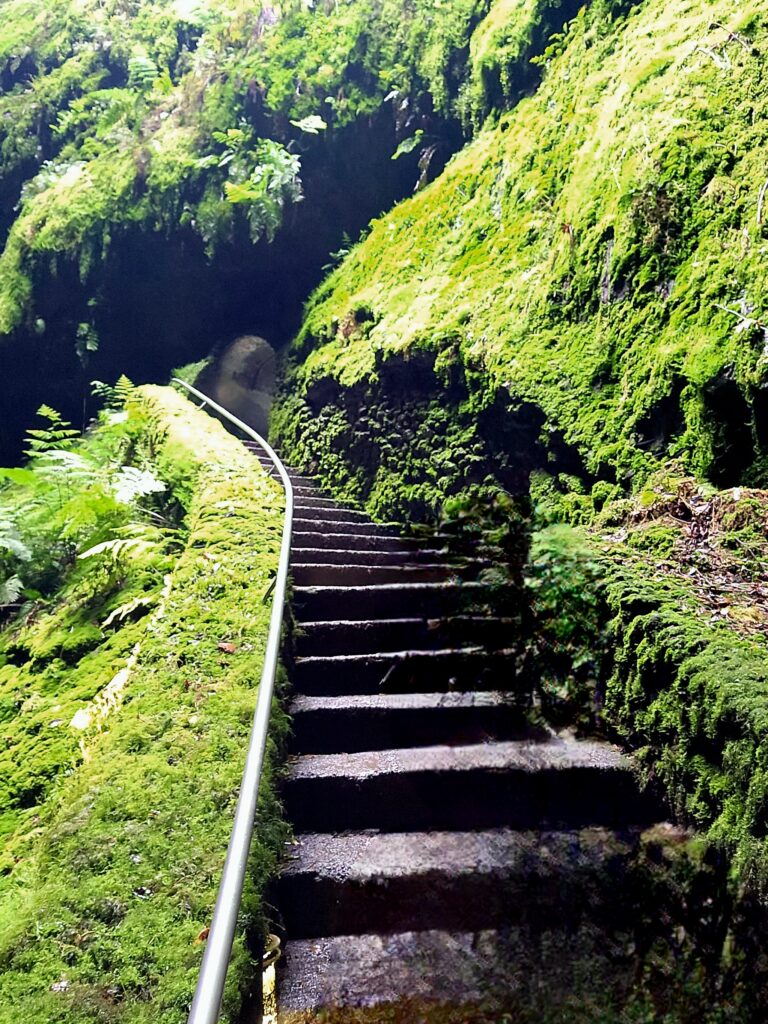
Centuries-old Churches
More than five centuries of history have formed the Azorean character and inspired religious traditions. The architecture and artistry create a legacy on the islands. Many religious celebrations only occur in the Azores, while others emphasize the bond to worldwide festivities. Religious festivals attract visitors year-round, but the most significant events occur between April and September.
On São Jorge Island, in the Manadas parish, you’ll find the 18th-century Baroque Santa Bárbara. While on Terceira, Angra do Heroísmo is home to the 16th century Santíssimo Salvador da Sé Church, the largest temple in the archipelago and the only cathedral found in the Azores.

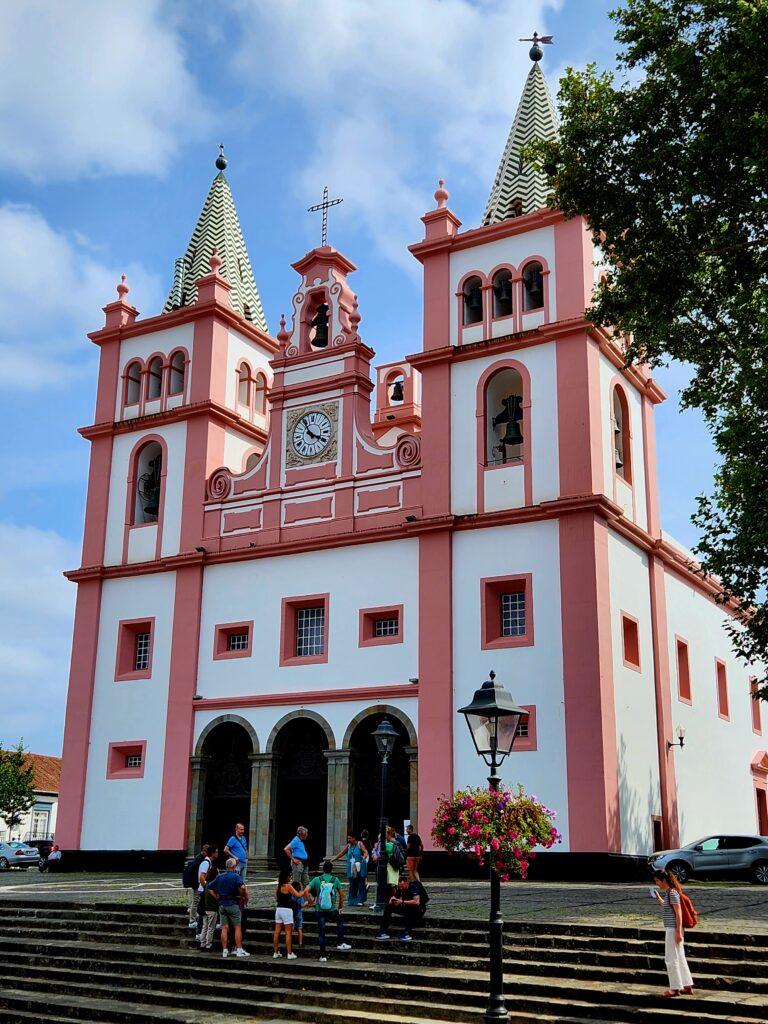
People throughout the Azores Islands are devoted to the Virgin Mary and honor her with processions and pilgrimages in nearly every island town. I was fortunate to be on Terceira the second weekend of September, the date of one of the largest and most significant celebrations of the Virgin. And, on the day after a detached retina caused blindness in my left eye, I walked with thousands of believers in the annual Our Lady of Miracles procession in Serreta.
The pilgrimage dates back seven centuries to the late 1500s and is spread over two days, Friday and Saturday. My travel companions and guides lit candles and prayed to Mary for a miraculous healing of my eye. The weekend culminates with a festival on Sunday and Monday.

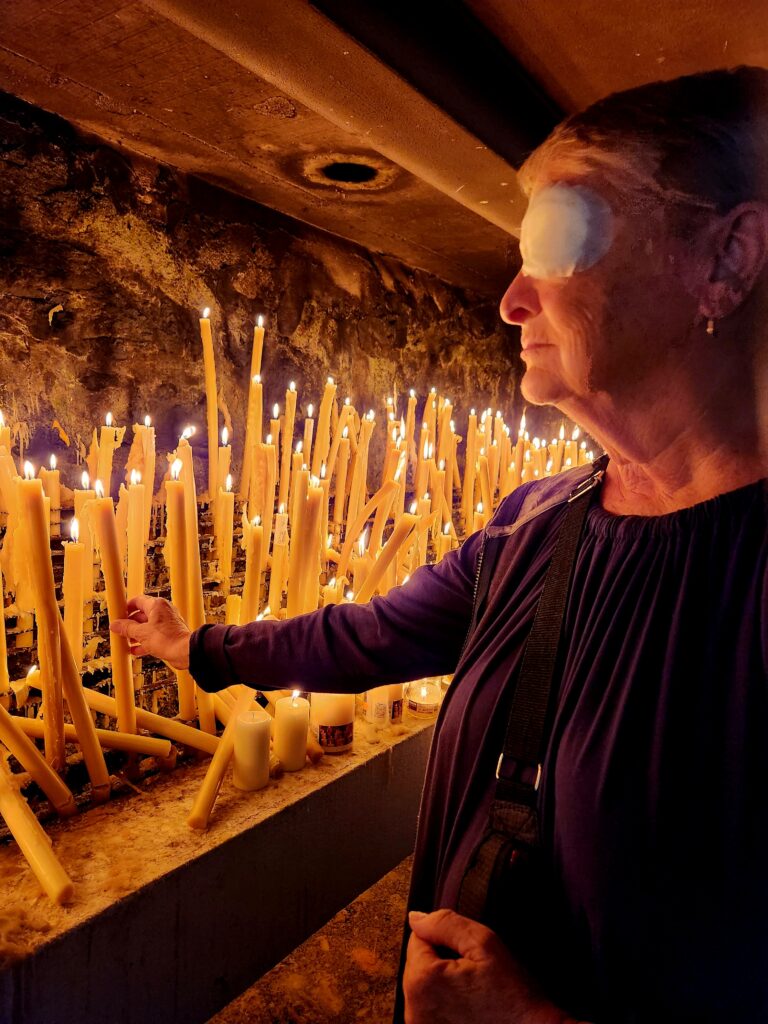
Igreja de São Gonçalo
Igreja de São Gonçalo was established in 1545, specifically for the nuns of the Order of Saint Clare. It is the largest convent in Angra. The baroque-style interior has a row of chairs for the upper choir, elaborate figures carved on the chair arms, and a painted ceiling from the 18th century. A nun gives tours of the convent.

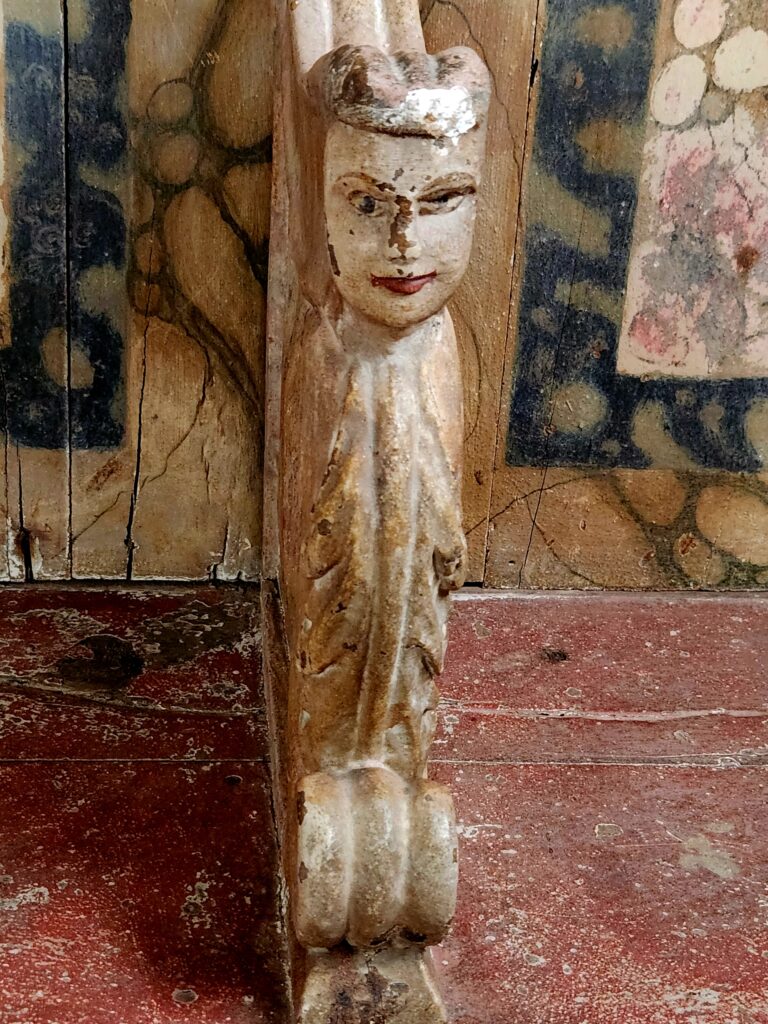
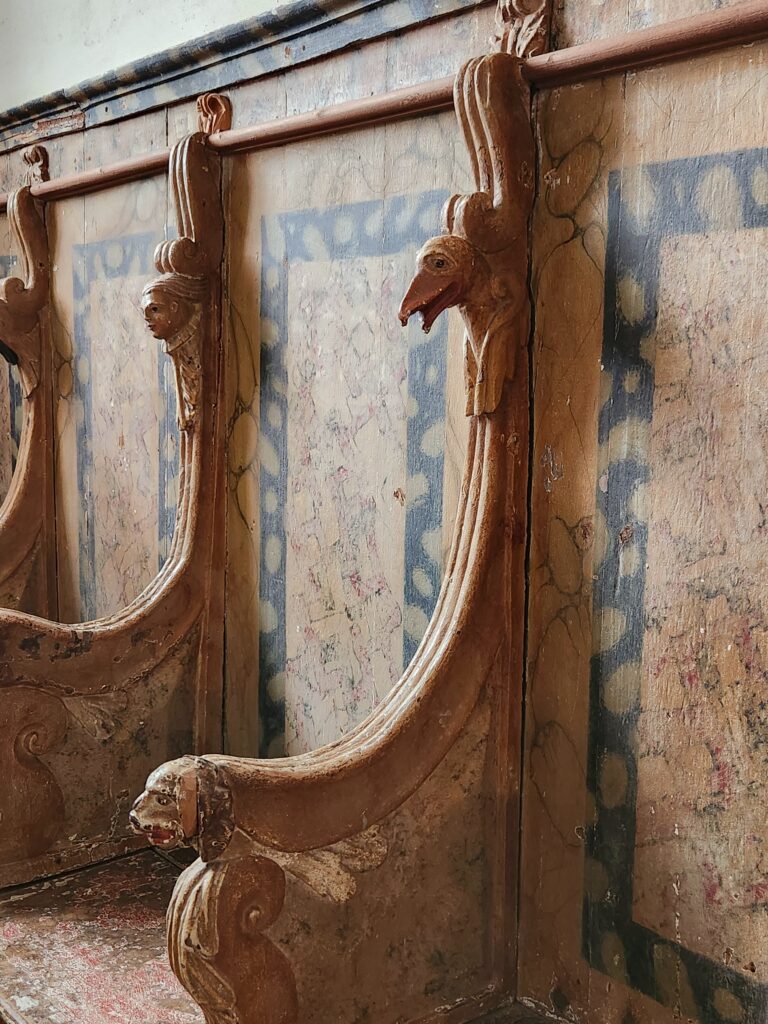
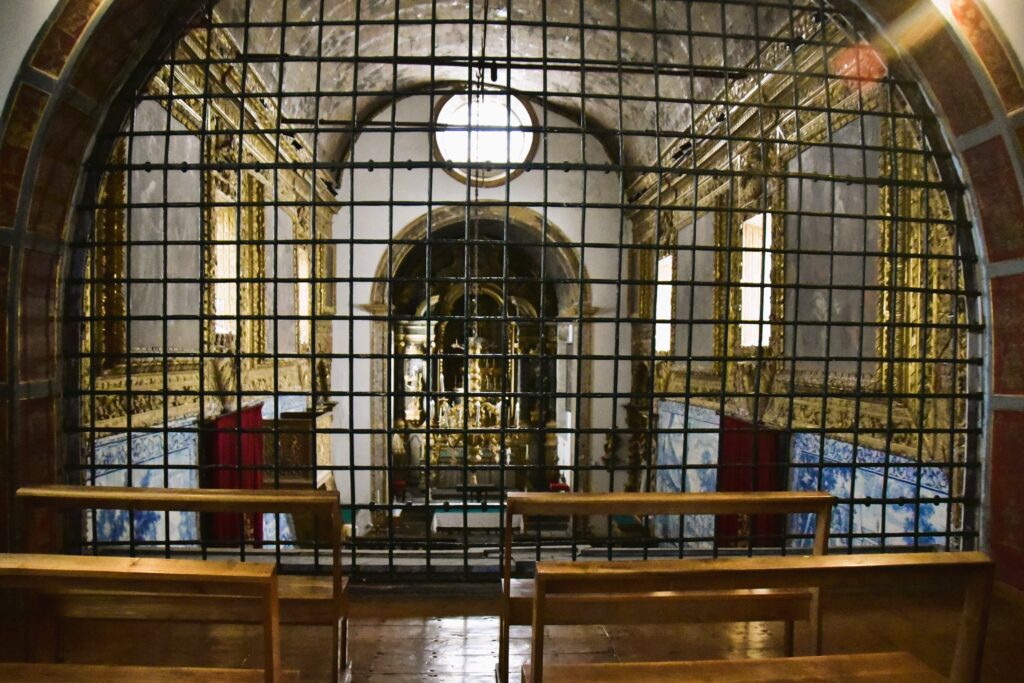
Igreja da Misericordia
Igreja da Misericordia, the Church of Mercy, was built on the location of the first hospital of the Azores Islands and founded in 1492. The original church joined the Brotherhood of the Holy Spirit in 1498 to manage the hospital. It is a beautiful blue church, and unusual because it has two alters due to two churches being located here. Inside is a 200-year-old organ and artifacts of the church. The church is a short walk from the Angra downtown and waterfront area.
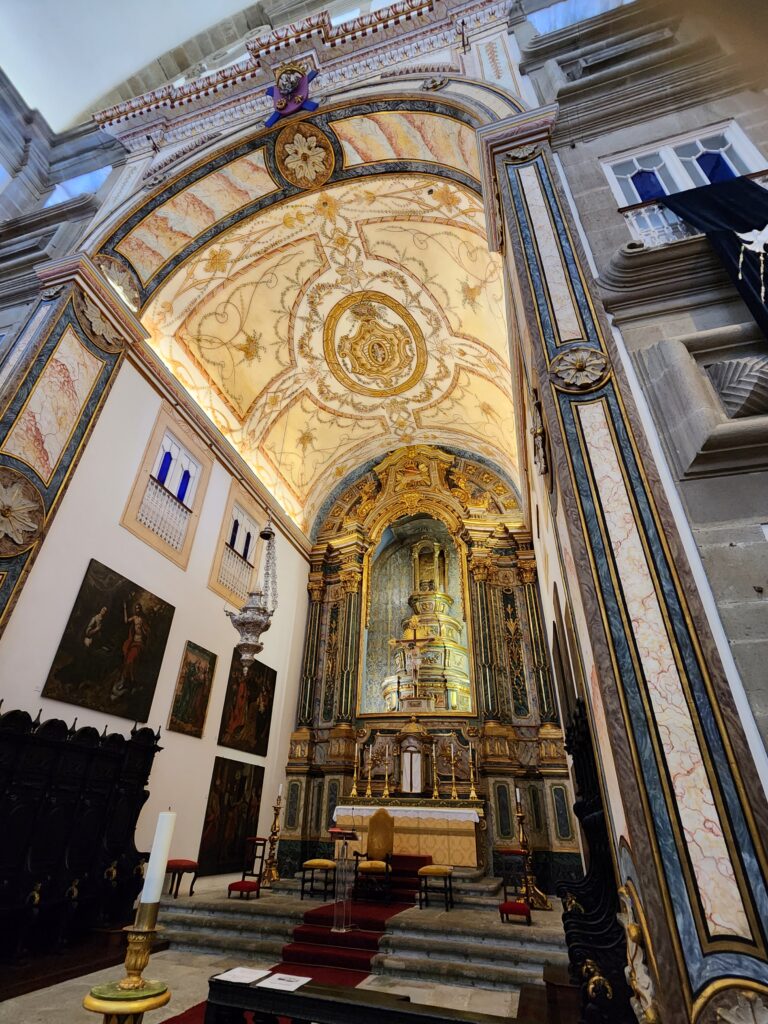
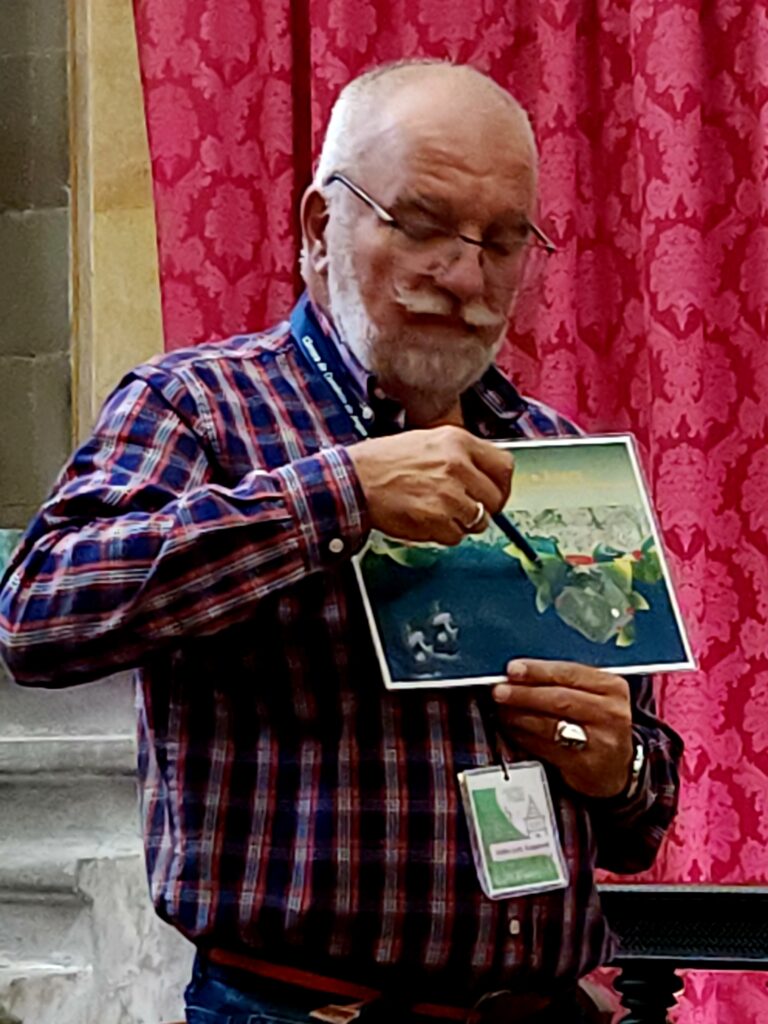
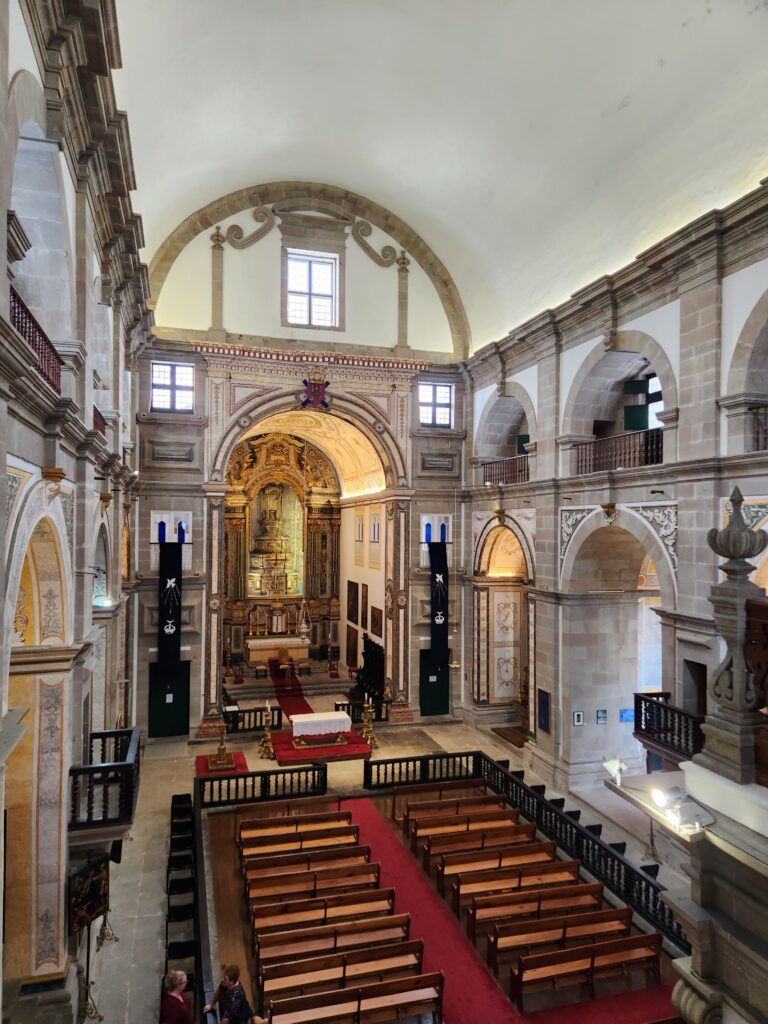
Botanical Gardens
The Jardim Duque Da Terceira, Duke of Terceira Garden, is a restful spot tucked into the hillside of Angra do Heroísmo. The Garden has dozens of exotic species collected worldwide during maritime adventures. Mosaics on the paving stone walkways create plants, animals, and famous people like Almeida Garrett, the founder of Romanticism in Portugal.
I especially loved the beautiful tile plaques displaying the botanical names of plants, and showing their country of origin. The two levels of this Garden open daily at 8 am and close according to the sunset, which ranges from 5:30 to 10 pm during the year.

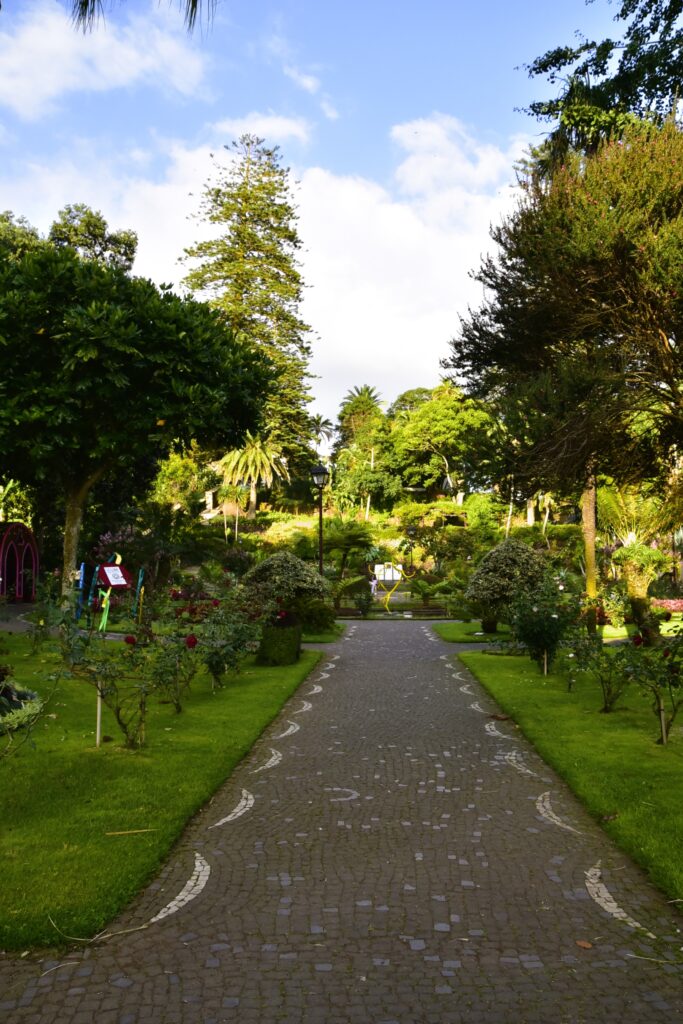
From Sea to Plate – Fresh Seafood and Delectable Desserts in the Azores Islands
Naturally, Terceira and São Jorge are surrounded by seafood (islands, people!), so fish and other seafood appear in every meal. My kind of place! But my favorite dish just may be Dona Amélias.
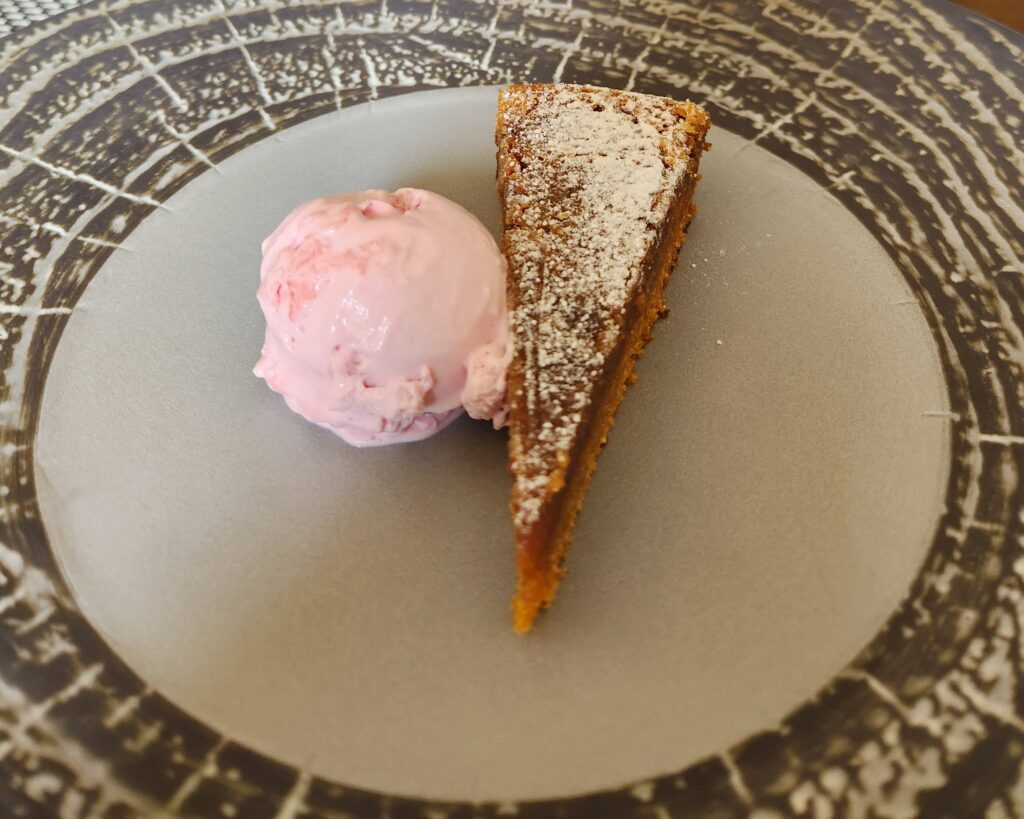
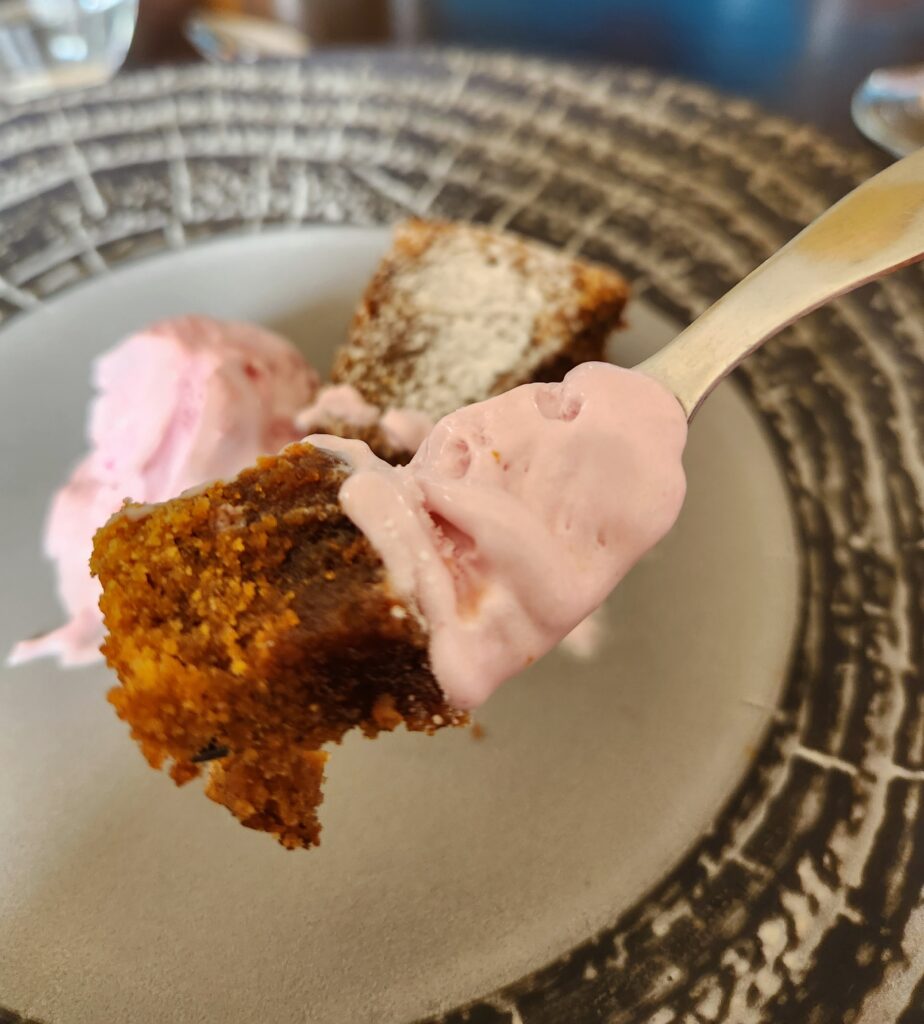
My first one was served for dessert at lunch the first day. Dona Amélias are traditional Portuguese tea cakes, originally called Indianos; the name was changed to honor Portugal’s Queen Amelia when she and King Carlos visited the island in 1901. I had Dona Amélias almost every day (did I just admit that!?), and yes, I have the recipe. Cakes filled with cinnamon, nutmeg, and molasses—what’s not to love?
Local restaurants served drool-worthy food everywhere we went in the Azores Islands. Breakfast spreads with pancakes, eggs, bacon, pastries, cheeses, and meats; Italian food; and rustic Portuguese food. You will not go hungry in the Azores.
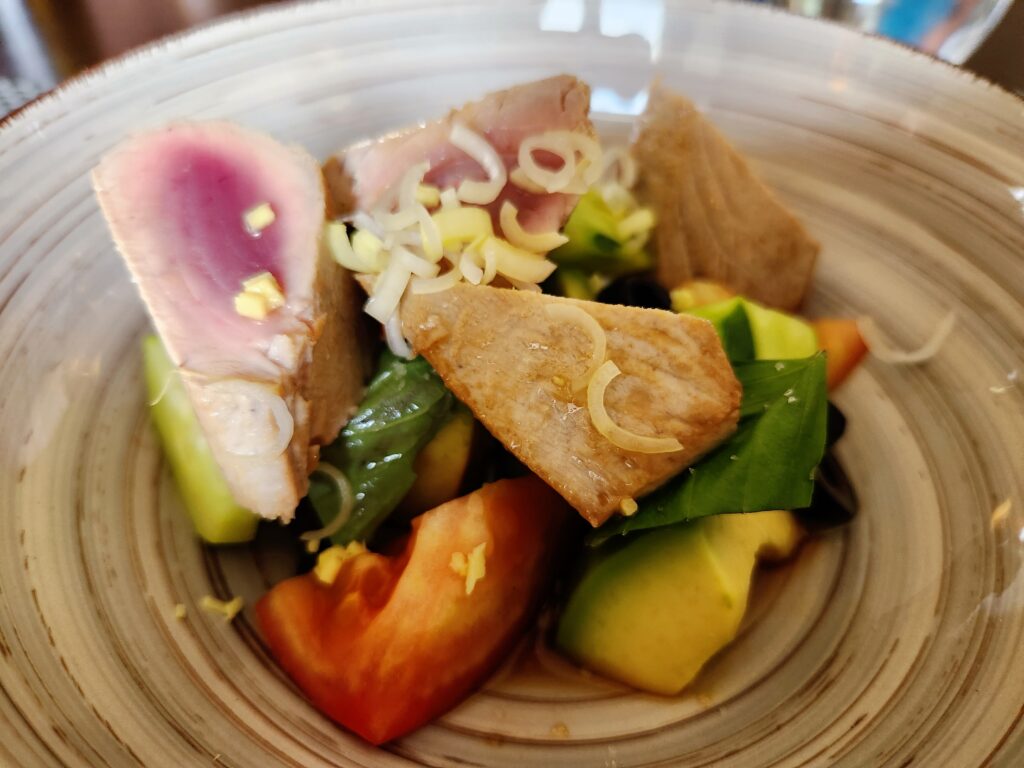
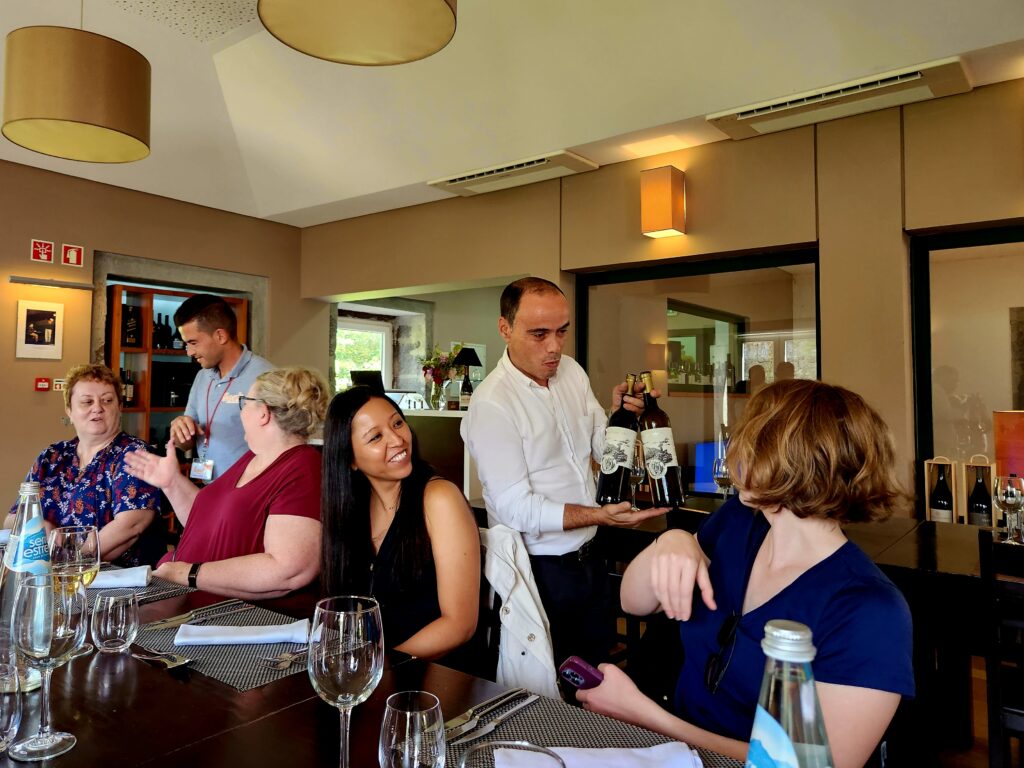
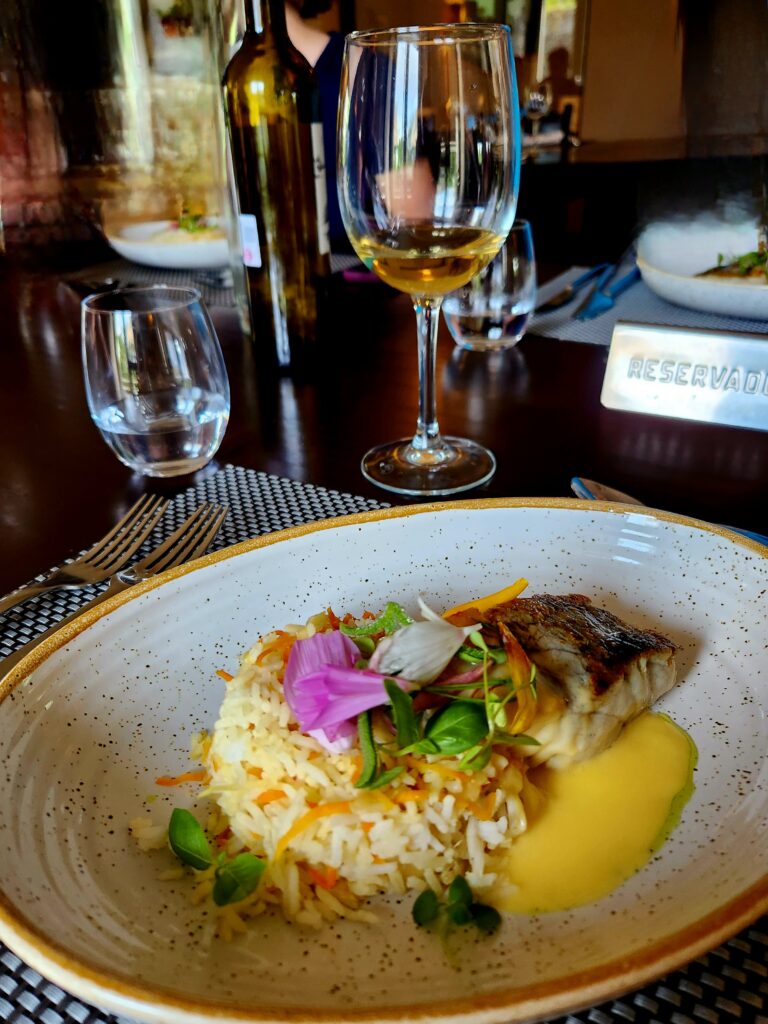
I missed eating cozido das furnas, literally food cooked by a volcano. On the island of São Miguel in the Azores, the village of Furnas is surrounded by boiling water springs and offers this unique eating experience. Relying on thermal waters, a huge pot filled with various meats and vegetables is placed underground and slowly cooked by the hot springs’ steam for five hours. I need to visit this unique place. And take my swimsuit—after all, thermal waters mean thermal baths!
Azores Islands Portuguese Wine History
Viticulture was introduced in the Azores Islands in the early 1400s by Henry the Navigator or Franciscan monks, depending on who you believe. Either way, due to these Portuguese islands’ humid, mild climate, vines flourished on all nine of the Azores Islands. By the 1800s, producers created more than 13.4 million liters of wine annually. They exported it to the United States, Brazil, England, and Russia. Vineyards entirely covered Pico Island. However, the arrival of powdery mildew and phylloxera in the mid-1850s devastated vines and dropped production.
Today, only four islands have renewed the tradition of winemaking: Pico, Terceria, Graciosa, and Sao Miguel Island. These wonderful islands are some of the best places in the Azores for grape production. The area is home to 33 different grape varieties, about evenly divided between red and white. I suspect that the thermal waters provide additional protection from frost for vineyards growing on São Miguel Island.
The volcanic rock walls that divide vines into cerrados on the island of Pico are listed as a UNESCO World Heritage site. The growing areas in the Azores are distinct and different from the vineyards on Italian or French hillsides. Beautiful but different is always a plus.
We visited Biscoitos Wine Museum, a museum of wine making in the Azores Islands. Along with exhibits of ancient tools and winemaking utensils, there are stone harvesting tools once used in the outdoor area. There is also a vineyard and wine tastings are offered in their barrel room.
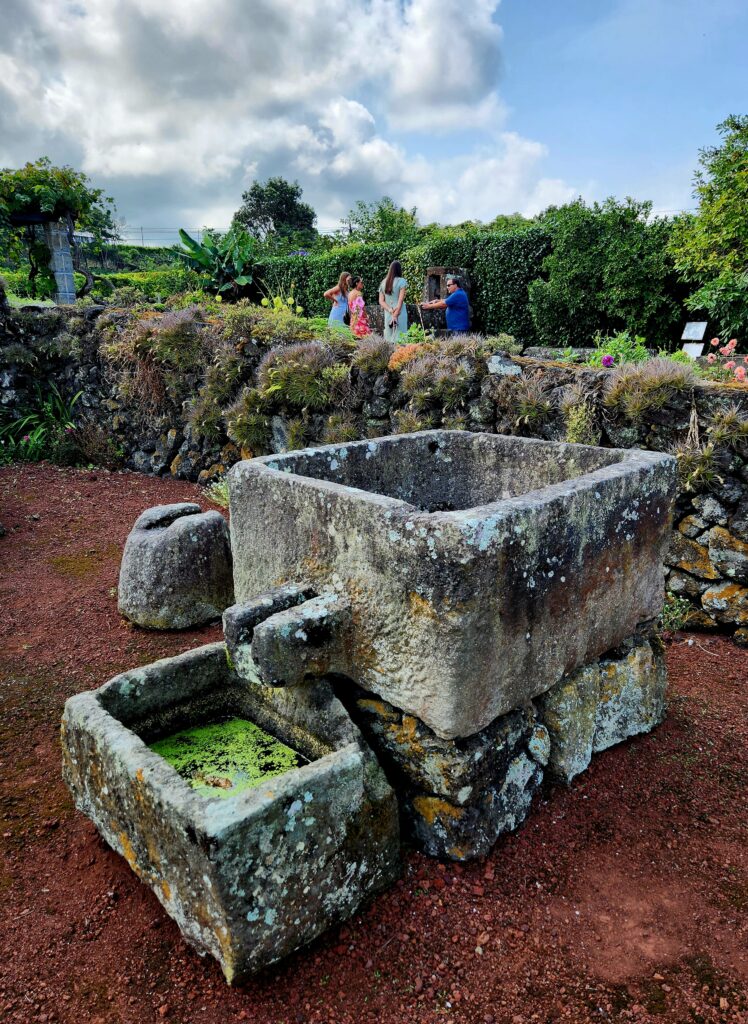
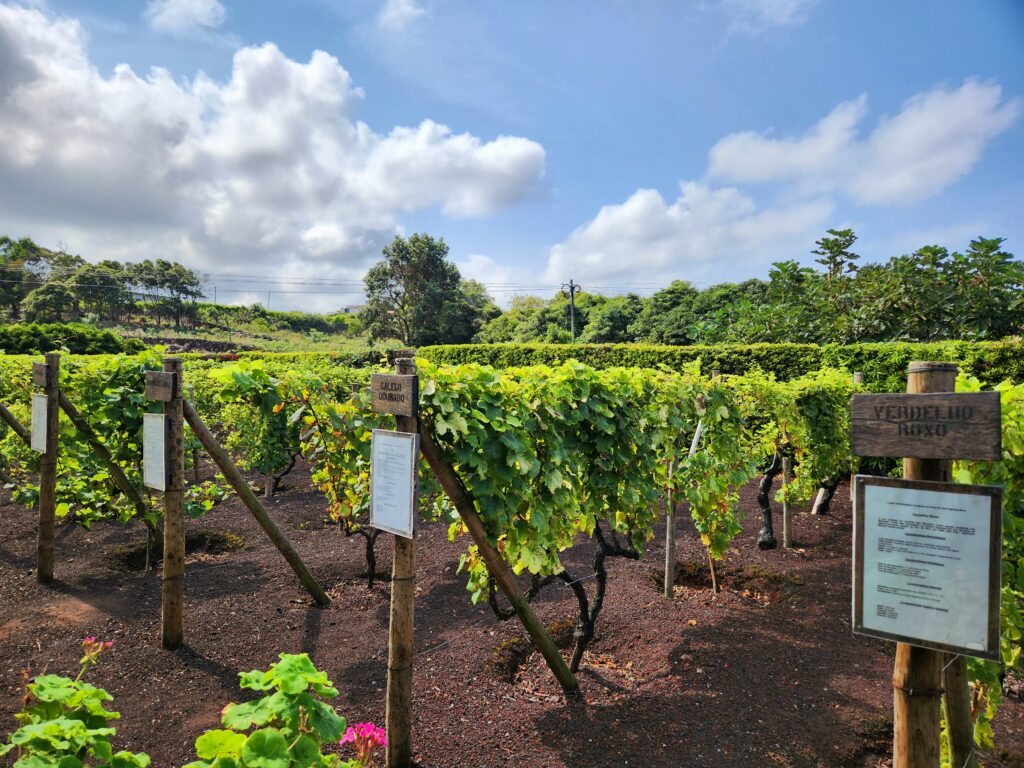
Wines That Tickled My Taste Buds
We drank delicious wines with lunch and dinner, but I’ll save those stories for my food article. Let me tell you about the two I brought home. The Inn always had a bottle of this wine on my dresser when I returned to my room—the Montaria Reserve Red from Parras Wines in the Alentejo region of mainland Portugal. Winemaker Vera Moreira blends Aragonêz, Syrah, and Trincadeira grapes to produce a ruby-colored wine with aromas of wild fruit and dark chocolate. It put a smile on my face every night.
Another treat that traveled home with me from the Azores Islands was the Chico Maria from Vinhos dos Biscoitos on Terceira. Founded in 1890 by Francisco Maria Brum, this century-old wine producer has grown grapes surrounded by loose stone walls that protect from wind and seawater for five generations. The unique wine comes from grapes grown in disintegrated basalt slag, the remains of a volcanic eruption. The obsidian layer encourages rapid drainage, so grapevines don’t have “wet feet.” In addition, the mountains surrounding the region protect the vines from coastal winds, and the elevation provides cool temperatures that produce elegant wines.
Chico Maria is a fortified, or sweet, wine made from ancient grape varieties. It is a rich straw color and smells of dried fruits, walnuts, and hazelnuts. The smooth wine is more of a liqueur. It makes a delightful appetizer with some cheese or an after-dinner aperitif. I’ve also enjoyed pairing it with a German Milk Chocolate, and you can read about pairing wine and chocolates in a recent article.
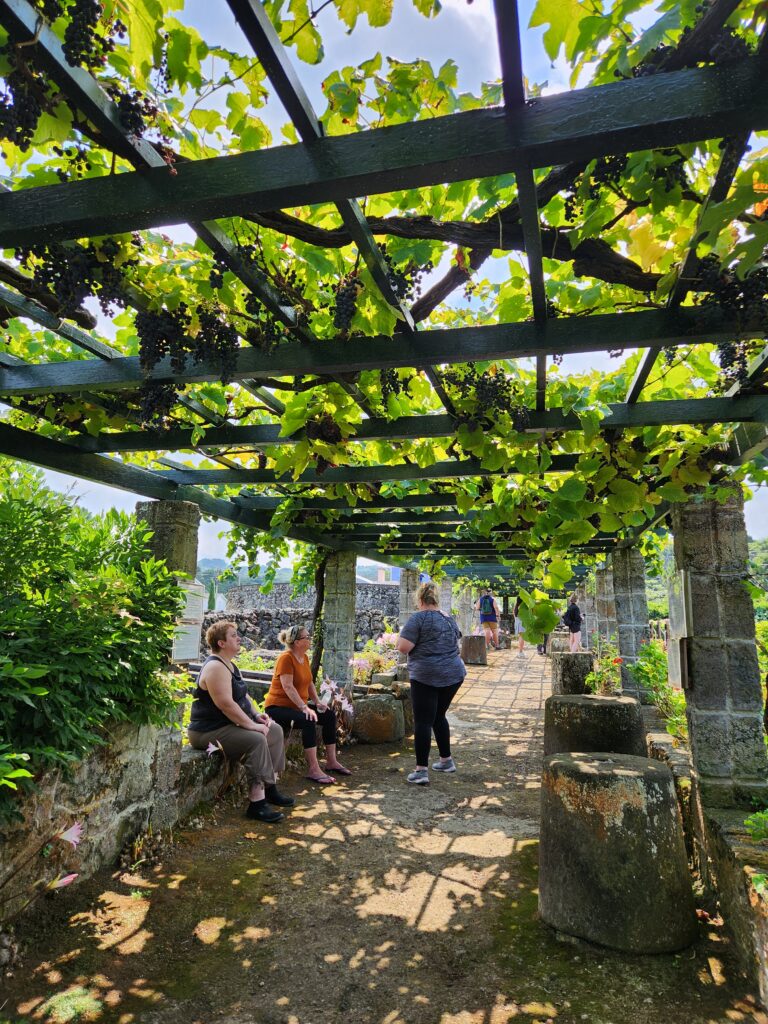

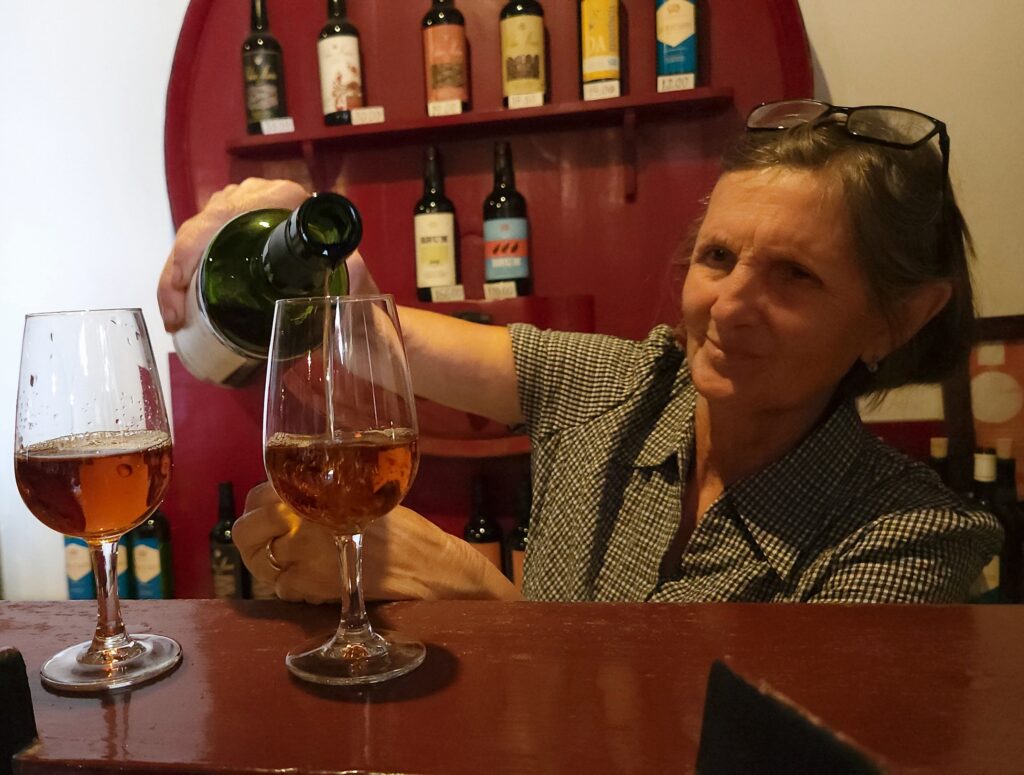
If You Are a Beer Drinker
If you are a beer lover, then a stop at the Beer Store is perfect for you. Hundreds of beers, from Corona to local IPAs, have made their way to the Azores Islands. The variety of tastings was ideal for a wine drinker to find something to love, and the food pairings put a smile on my face.
I enjoy looking at the creativity of labels, and these bottles did not disappoint. The store had videos running that showed where the beers were brewed, and told a bit about the taste sensations in each pour.
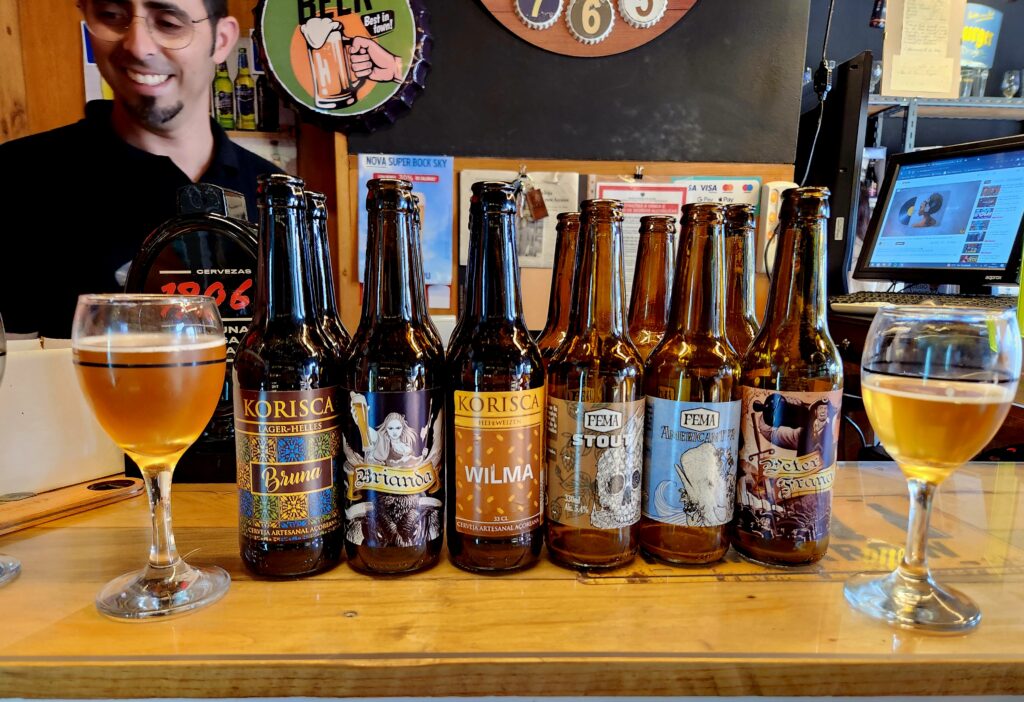
Where Can You Stay in the Azores Islands
An Internet search of the island you plan to visit will locate various lodging sites. But why choose a hotel when you can stay in a historic home?
Quinta da Nasce Agua is a hidden gem. Tucked into a quiet hillside in the Azores Islands, only a 10-minute walk from the Historic Center of Angra do Heroismo, the Quinta is peaceful and welcoming. It has the honor of being the first Azores accommodation to be classified by the government as a guest house.
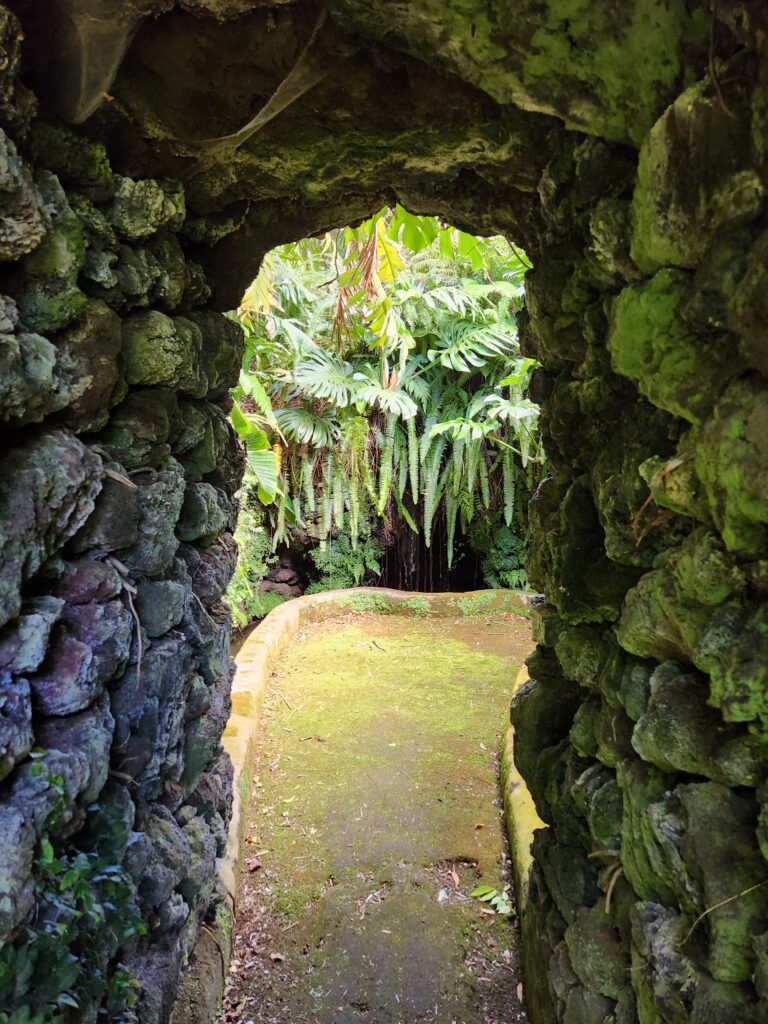
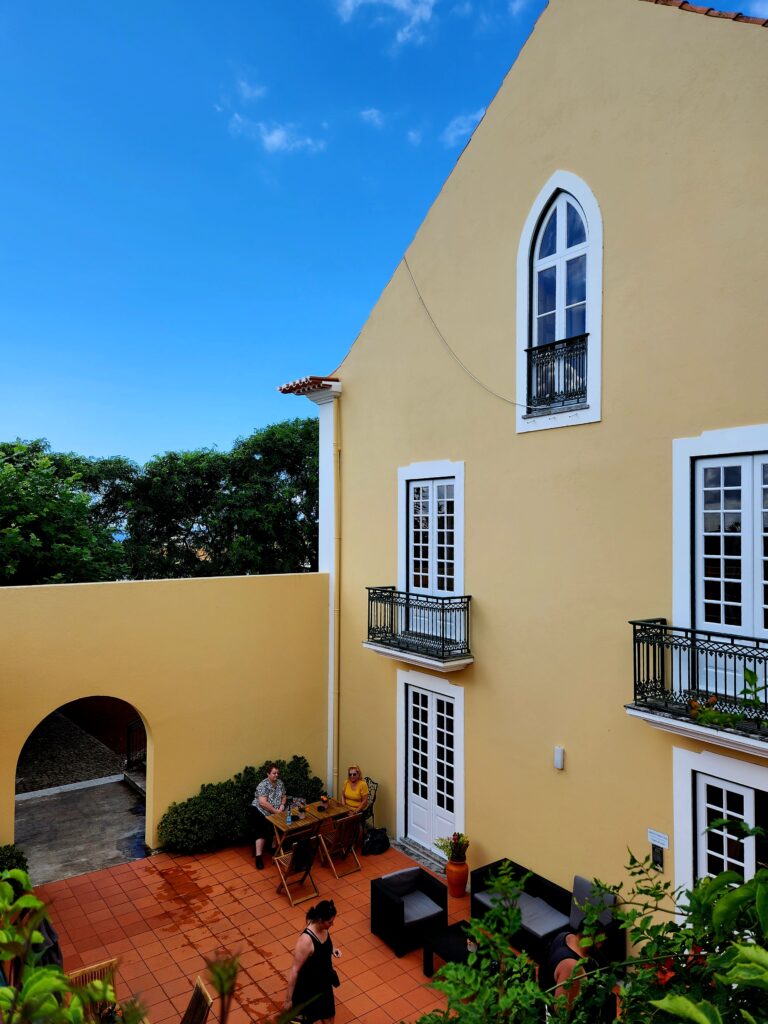
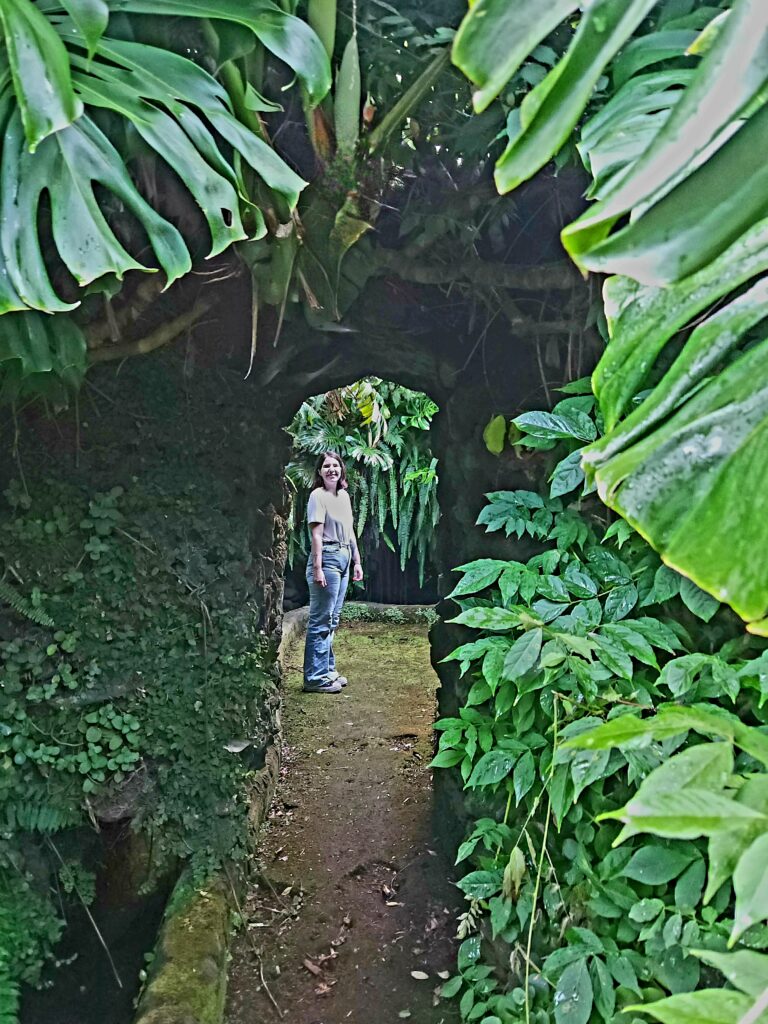
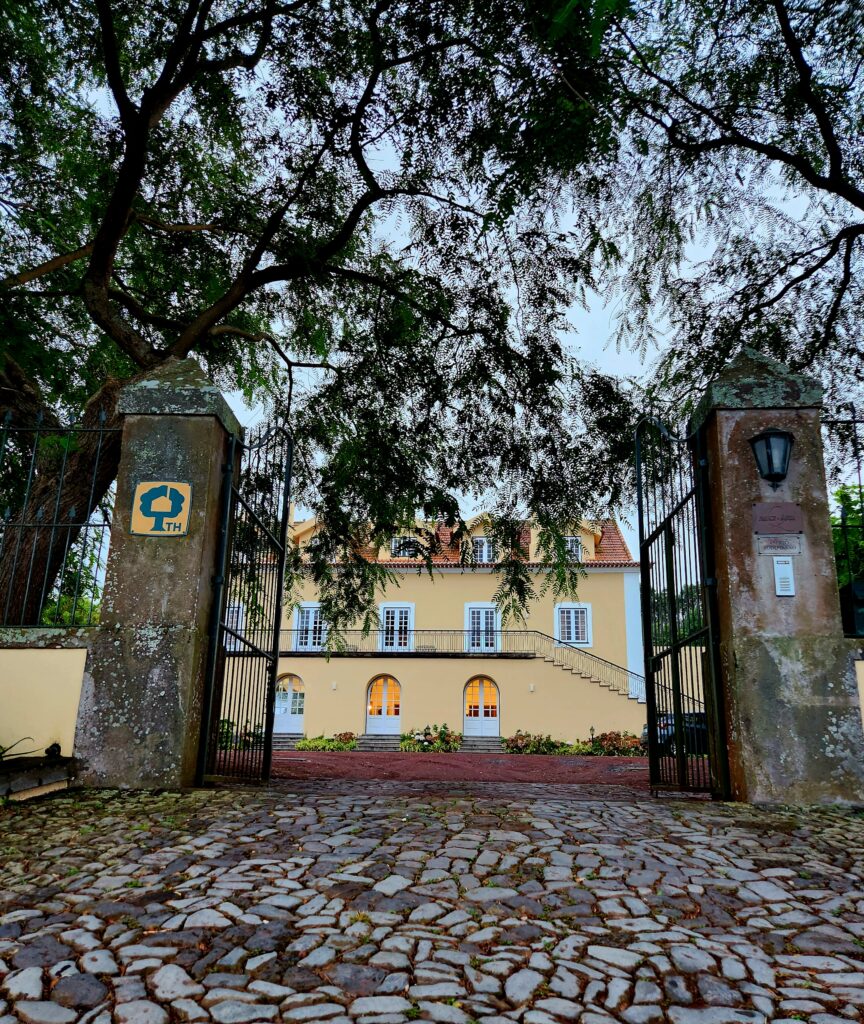
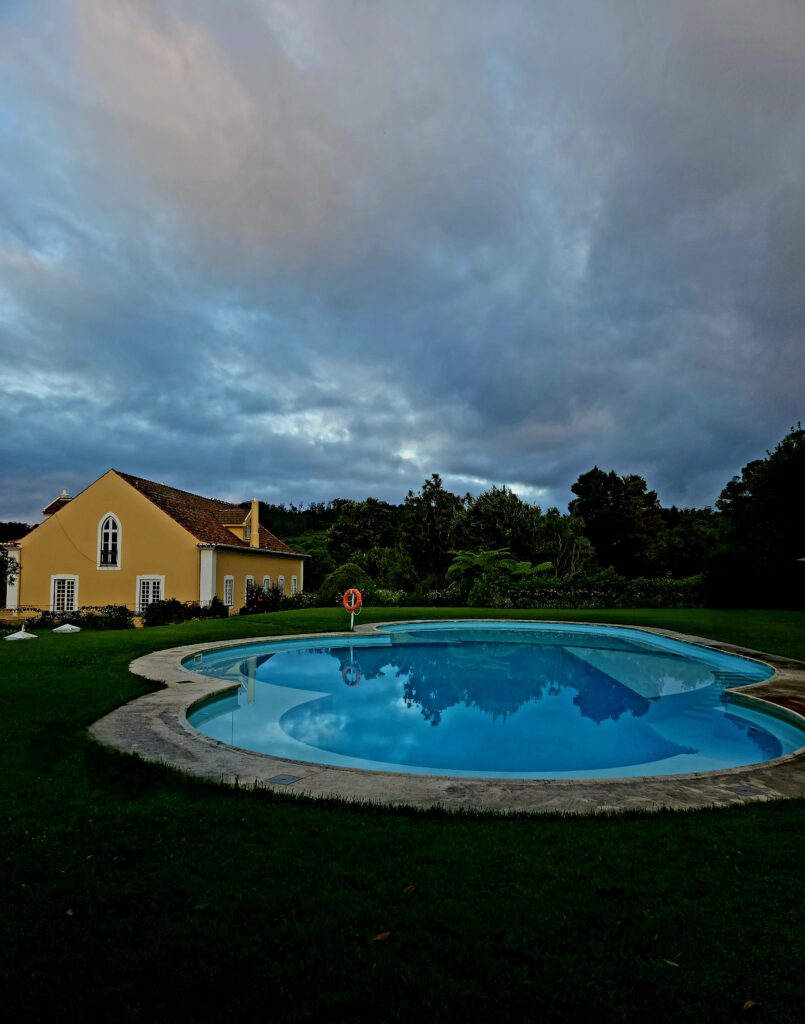
The restored 1899 home is beautifully decorated and surrounded by gardens, lawns, a duck pond, and a hidden cave. It offers the niceties you expect in a modern hotel, but it has so much more. Early each morning, I threw open my bedroom’s balcony doors to witness the ducks parade from their nightly nesting spot through the Garden to the pond.
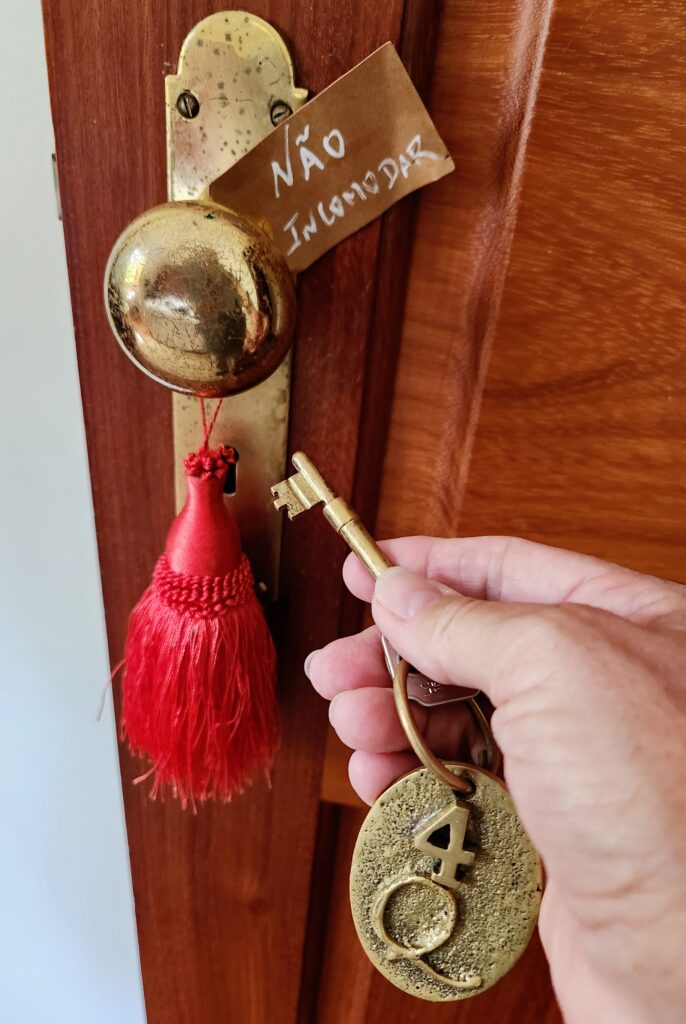
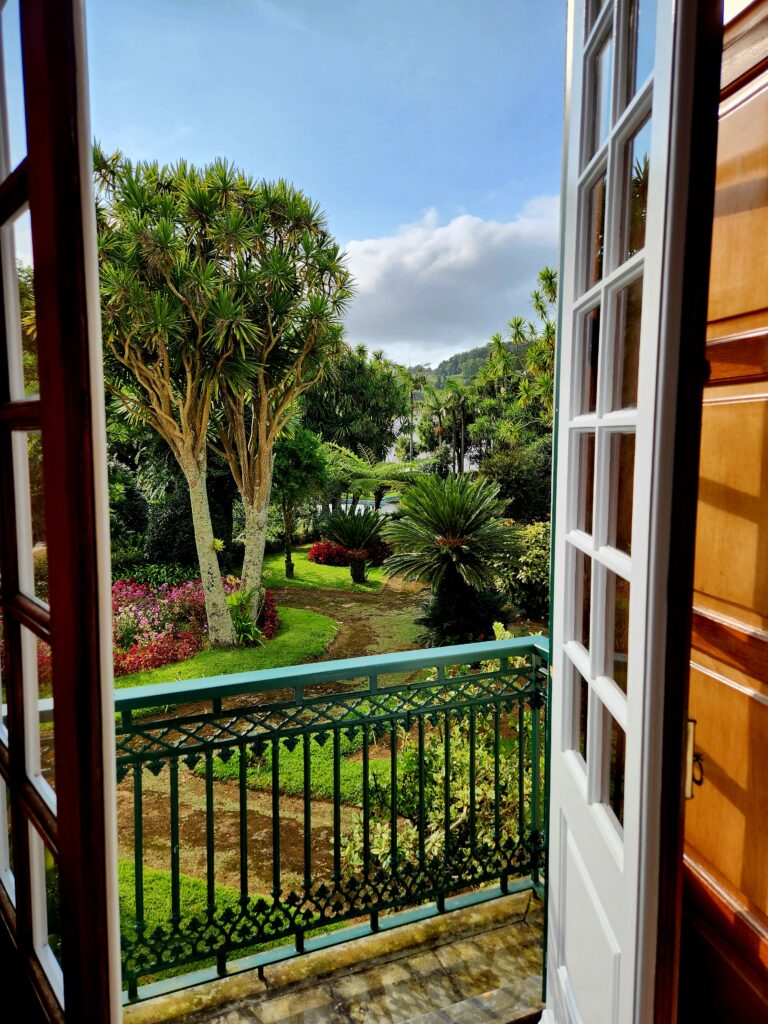
After my morning ritual, I headed downstairs for breakfast. Actually, I went for the red juice. I’m not sure what they mixed to make that stuff, but it was good.
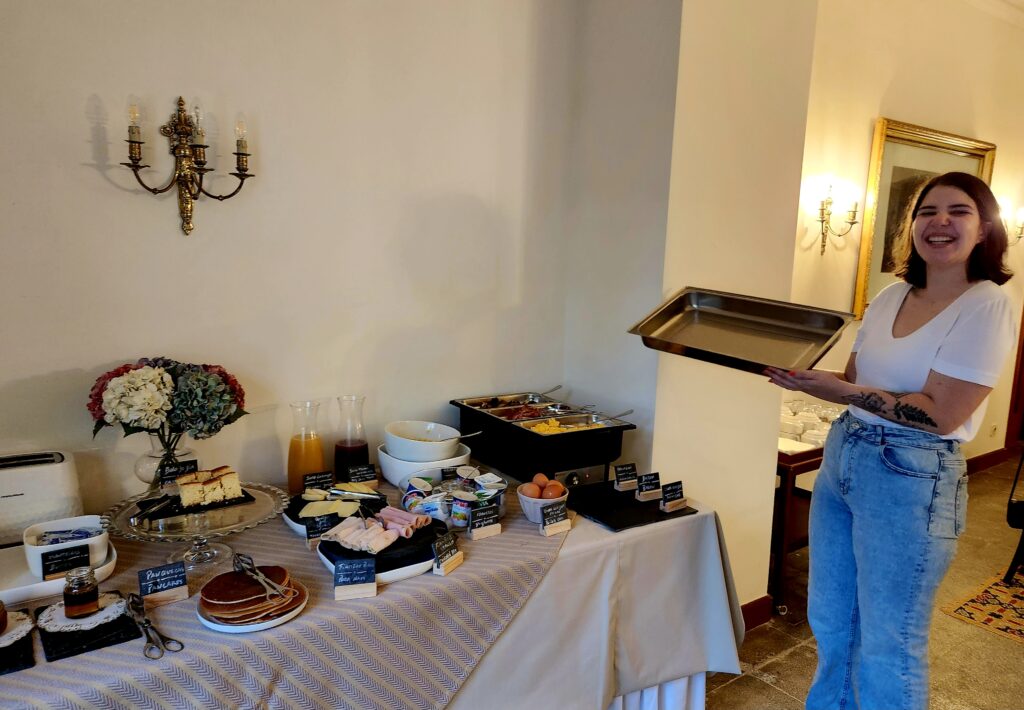
The staff quickly offers assistance with anything they think you want. After a long day of exploring, a bottle of wine, water, and fresh fruit waited on the dresser for a pick-me-up.
Dinner at the Inn
The Inn also serves dinner. Boy! That is such an understatement. People from town come to the Inn for dinner. I can tell you why. We had a delightful meal, enjoying fresh ocean Limpets with lemon, garlic, peppered butter, and ice plant for our appetizer.
The meal moved on to a Regional Fish Soup with Saffron. The fish course included Azorean fish with herbed wine sauce, sautéed potatoes, and Azorean Tuna with sweet potatoes and pumpkin with Orange Carrots. The entrees included Sirloin Steak with wine demi-glaze and a side of green beans, Seared Chicken Breast and Sausage with Polenta, and Sweet Corn Pickles. We topped it all off with pie served with homemade ice cream. Yes, this was one meal. But I ask you, could you pick just one or two things? Me either. Thankfully, wine aids digestion.
How Do I Find My Way Around the Azores Islands?
It is simple to locate a rental car and create a road trip, and local transfer companies and tour guides are available. But, if you prefer a bit more assistance, the best way to visit the Azores Islands is with a local tour guide.
Spot Tourism Activities employed our guide and driver. Local experts Pedro and Tiago were knowledgeable and excited to share their home with us. When I say “share,” the word comes across as “paid to guide.” With Spot and their guides, nothing could be further from the truth. We became friends, indeed, family. They listened to what we liked and adjusted plans to add more “spots” of interest to the daily schedule. We were introduced to their friends and participated in a religious pilgrimage with their wives and parents.
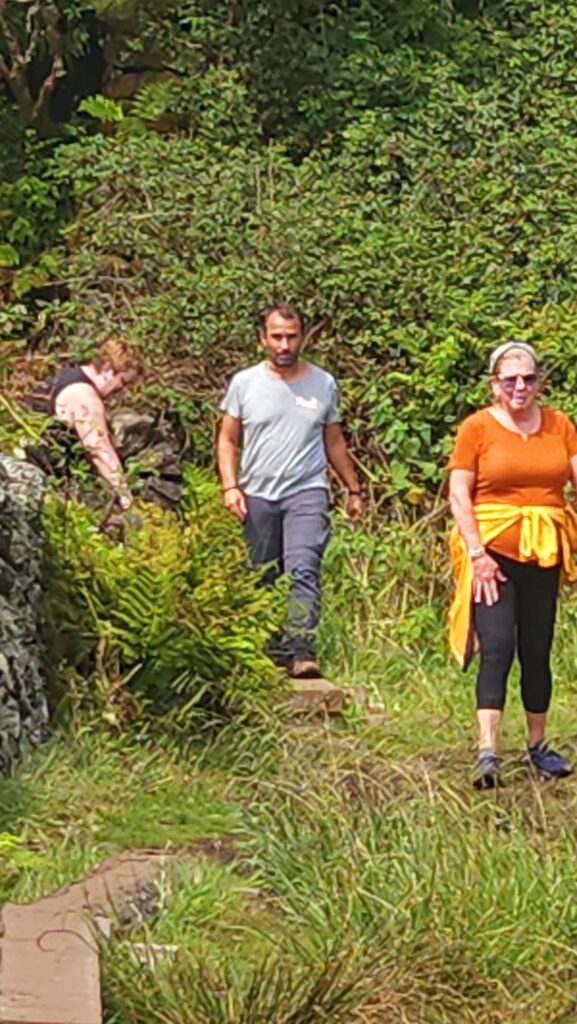
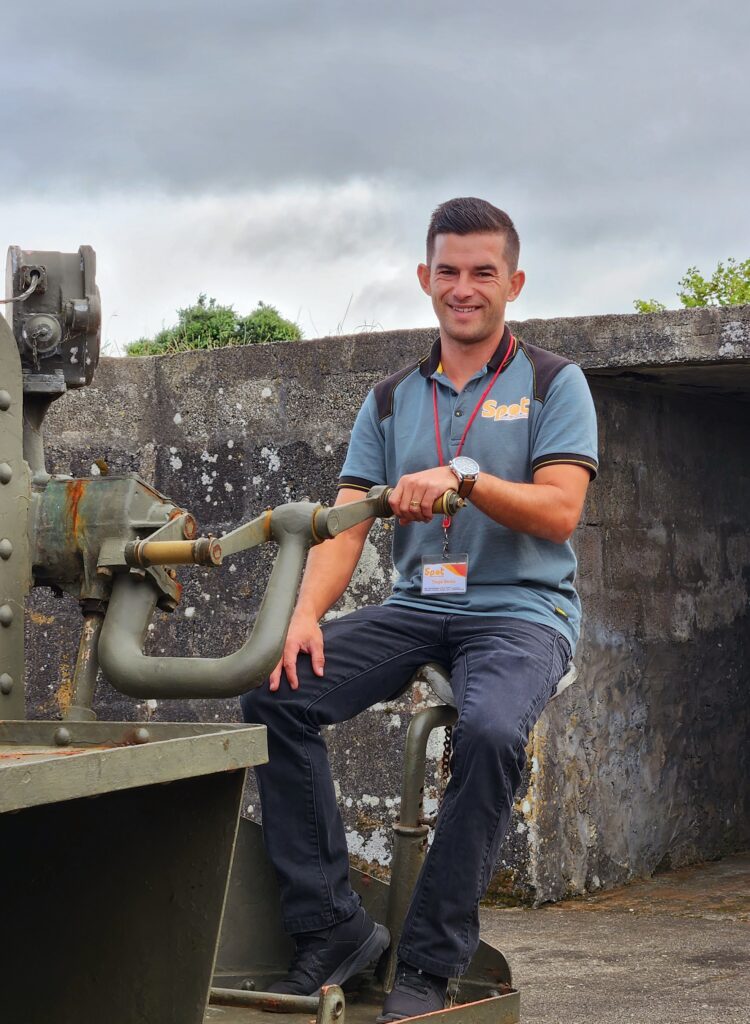
Pedro was full of stories about the island’s culture, traditions, history, and natural geological elements. He was interested in geo-caching, an event I’ve heard of but never tried. He and his wife enjoy it so much that I may have to try it.
When I had to visit the emergency room, my small group dropped me at the hospital and proceeded to the mountains. Pedro contacted Spot owner, Mónica, who came immediately, stayed with me, drove me to two pharmacies to find what I needed, and then called to locate my hiking friends across the island and got me to them. All on her Saturday morning off!
You can walk the area alone and find most signage in Portuguese and English. There is also an Angra City Pass for admission into nine places of interest for one price.
Are the People Friendly? Do They Speak English?
Everyone is friendly and helpful. Many speak English or try. You should, too–any attempt to say a few words will be met with a smile. Also, you can download a translation program on your phone.
Google Translate was a big help to me, especially in the emergency room. I typed in my symptoms, starting with the floater that looked like a looped piece of yarn and ending with the black curtain that ultimately ended all sight in my left eye. With this prepared statement translated, I could hand my phone to each caregiver and have an immediate understanding of my problem.
The visit to the pharmacy to purchase an eye patch was a different story. I decided to cover my eye since it hindered the good eye’s ability to focus. I tried to explain what I needed but ultimately resorted to clapping a hand over my eye and saying, “Pirate!” Pirate is pretty much the same in every language! LOL!
Can You Drink the Water?
Oh, my, YES! The water in the Azores Islands was fresh and clear and delivered to my room every day. I am a water drinker, so she quickly learned to bring two bottles, which I returned each morning for refills. But I want ice water, something other countries aren’t so fond of. So, a wide-mouthed water bottle to allow the addition of ice was a necessity.
Do You Need Traveler’s Insurance?
Ummm…well…how much money do you have? *giggle* What I can say about insurance is that if you are under 65 and have medical insurance, it will probably cover you in foreign countries, but do your homework to be sure. It probably won’t cover you if you are over 65 and on Medicare and a supplement. Medicare will not cover anything in another country. As soon as they deny the claim, your supplemental insurance will also.
I suffered a detached and torn retina on this trip and got a tour of the Angra do Heroismo Emergency Room. But, I had to hand over cold, hard cash to be seen. My reimbursement claim was easy to file with Allianz, and they returned the money and the $358 charge I incurred for changing my flight.
What is the Best Month to Visit the Azores Islands?
Like most places, the best time to visit the Azores Islands is from late spring to early autumn, from June through October. But, the moderate climate and sunshine can last until November. Then, too, the off-season of October until April can provide the perfect cool temperatures for hiking. And I’ll bet Christmas is lovely in the Azores. So go, just go.
Like me, this may be your first trip to the Azores, one of Europe’s best-kept secrets. But, like me, I doubt it will be the last! If you need contacts to plan your trip, hit me up—I know people. *smile* And in my next article about São Jorge, I’ll be telling you about a tea plantation, unspoiled nature, windmills, a luxury resort by the sea, and the chef who owns it.
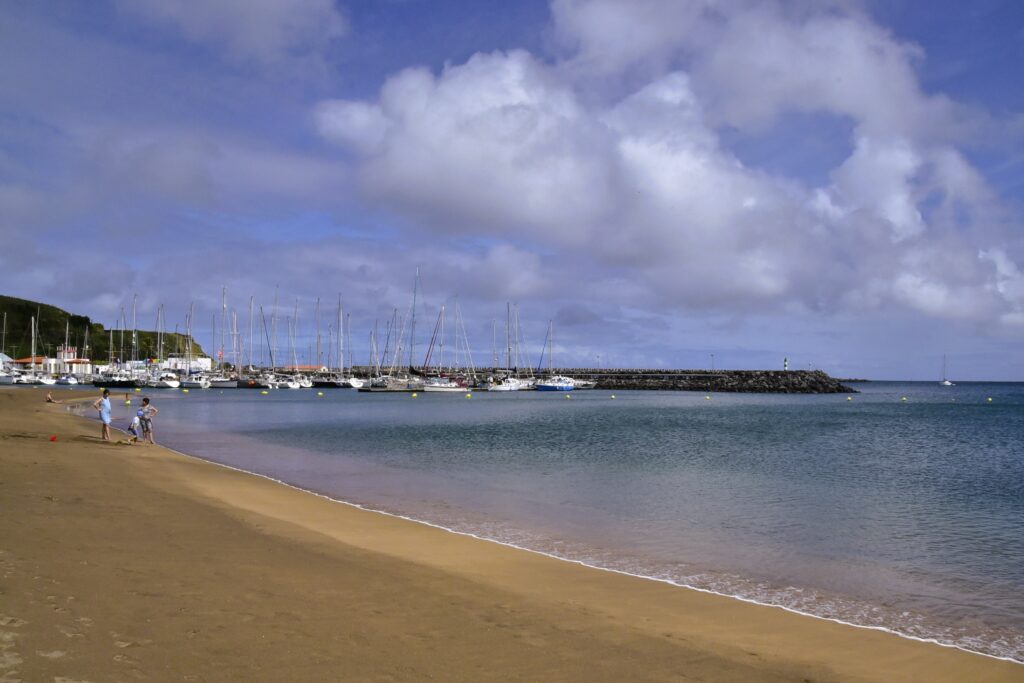
Plan Your Next Trip!
For more exciting vacations, try these locations!! Plan a cruise on the Discovery Princess, travel the Yadkin Valley Wine & ‘Shine Trail to try delicious North Carolina wines, or jet off to California and check out Half Moon Bay! You know, it’s never too early to start planning your next trip!

Another fabulous article! Azores is now on the bucket list!
Kim, you will adore the Azores! And their food – yummmmm!
Great article!
It is encouraging to know the water is clean and fresh!
Thanks, Kae!
I drank tap water everywhere I went, but icing it down was a bit harder. Who knew ice water was such an “American” thing?